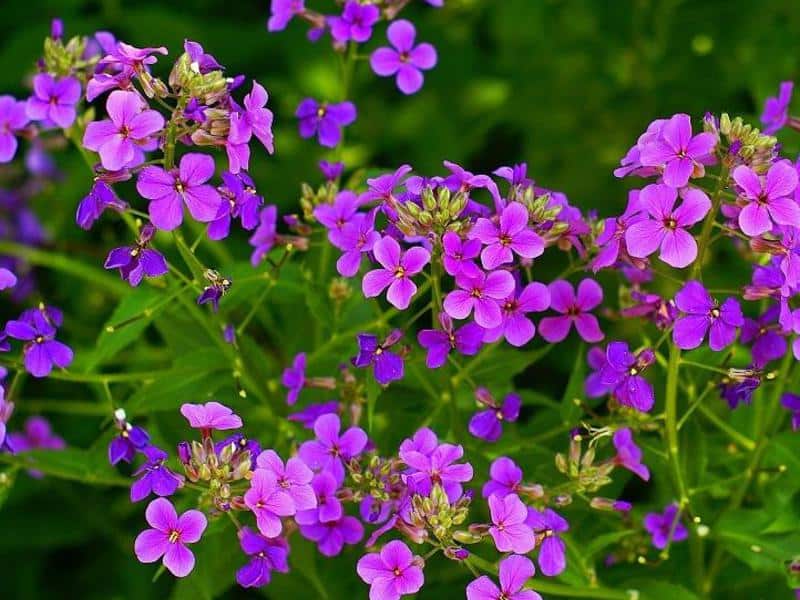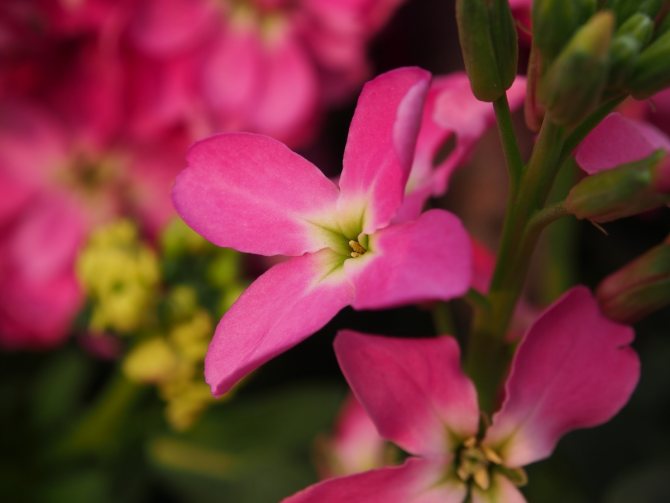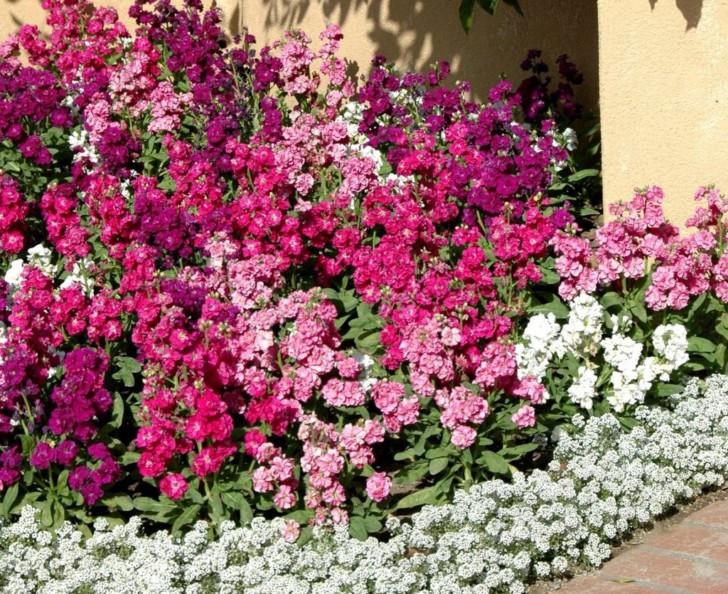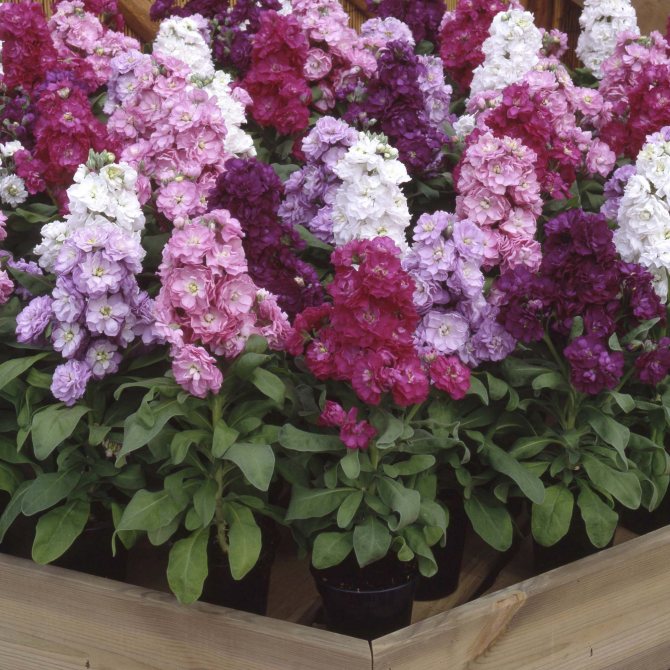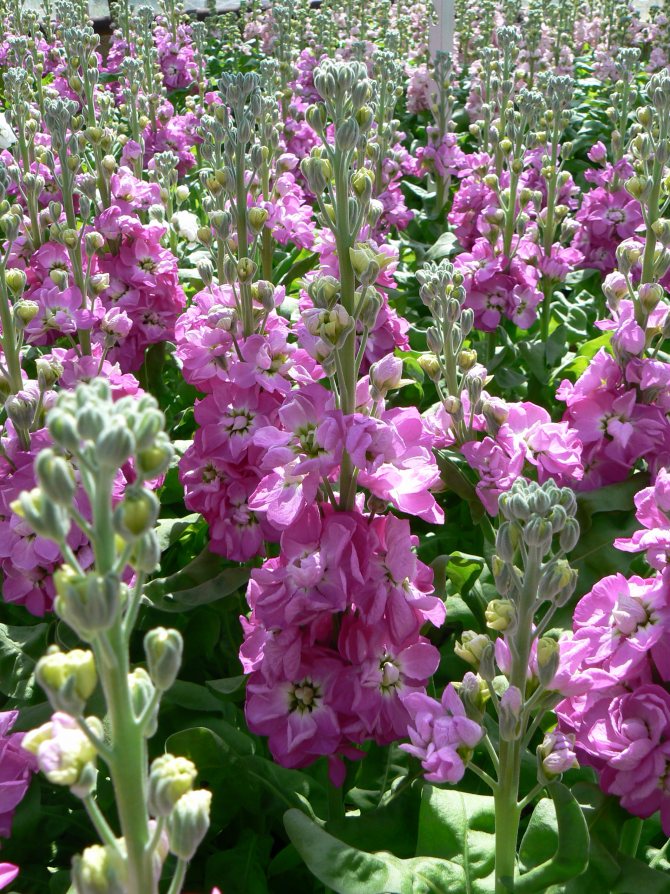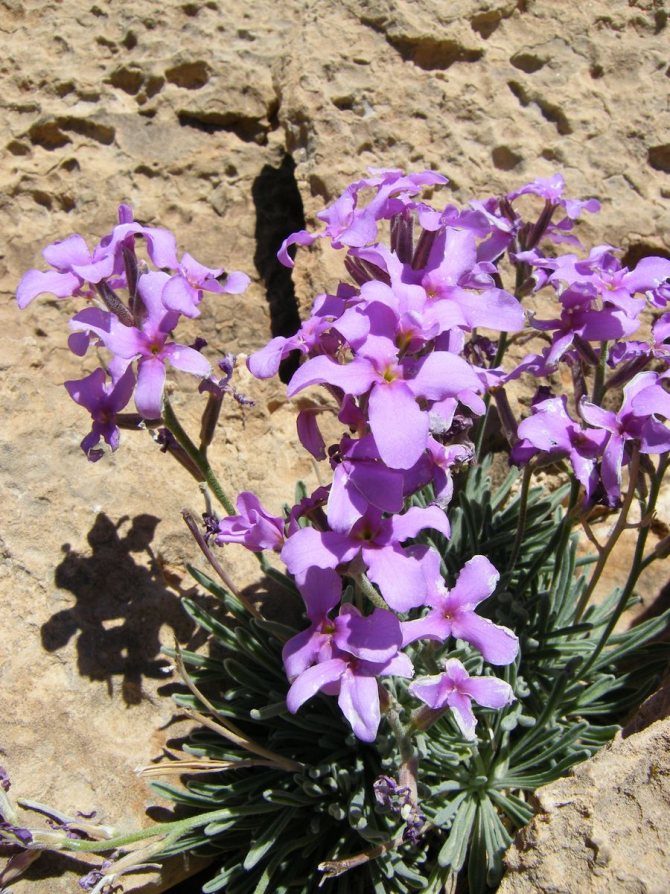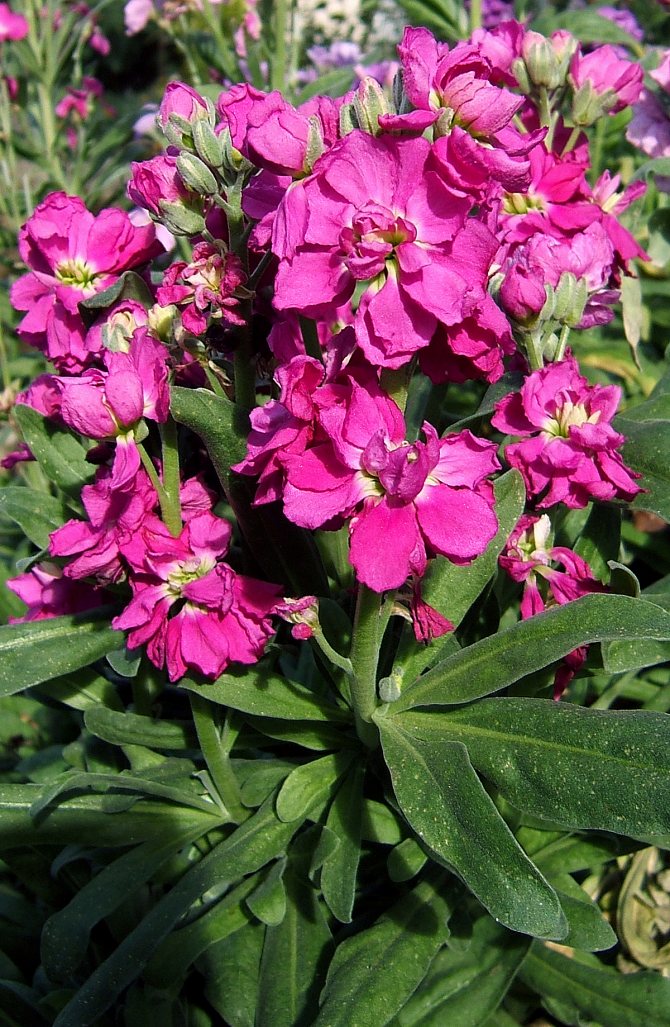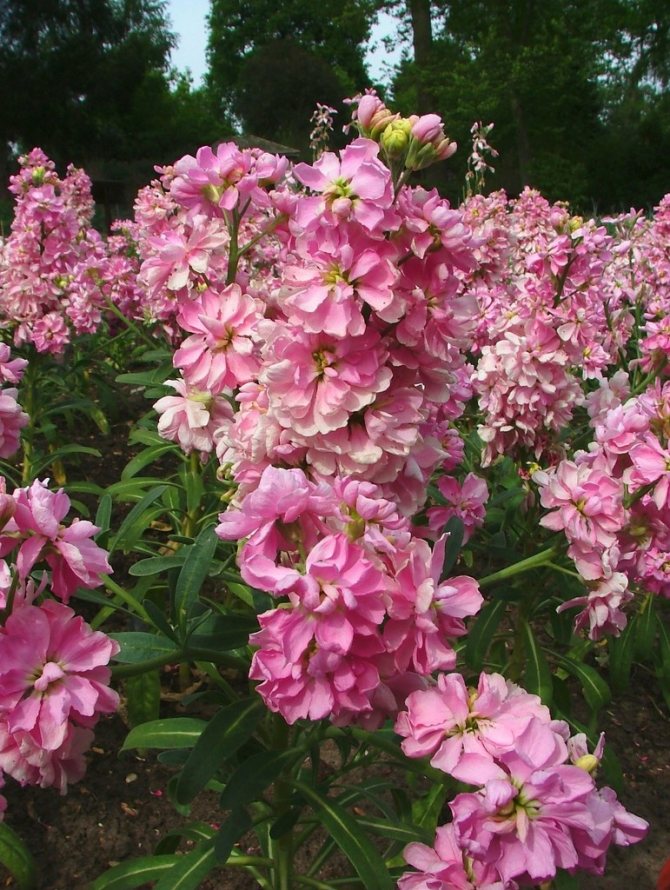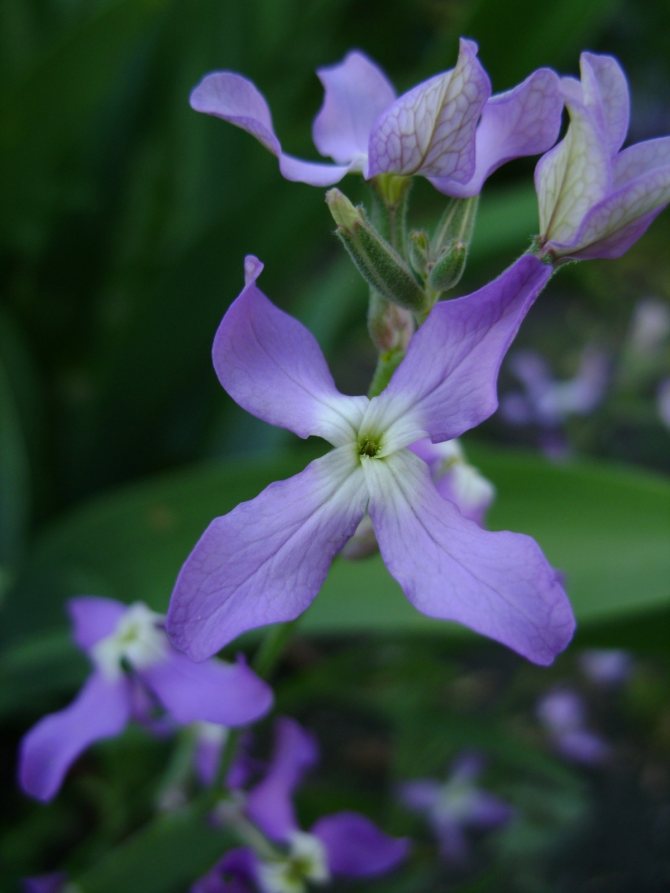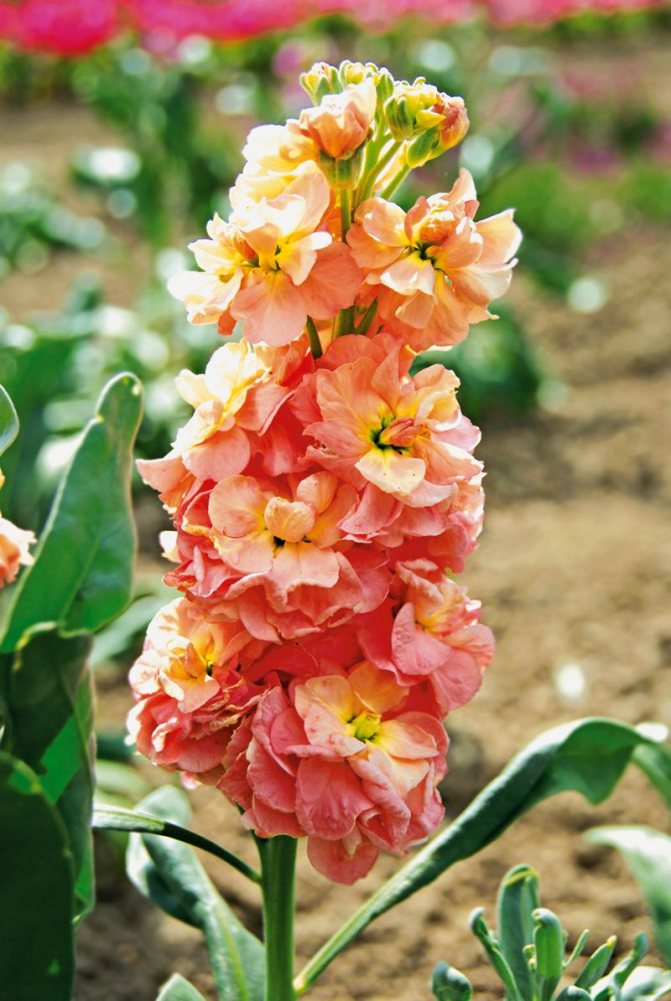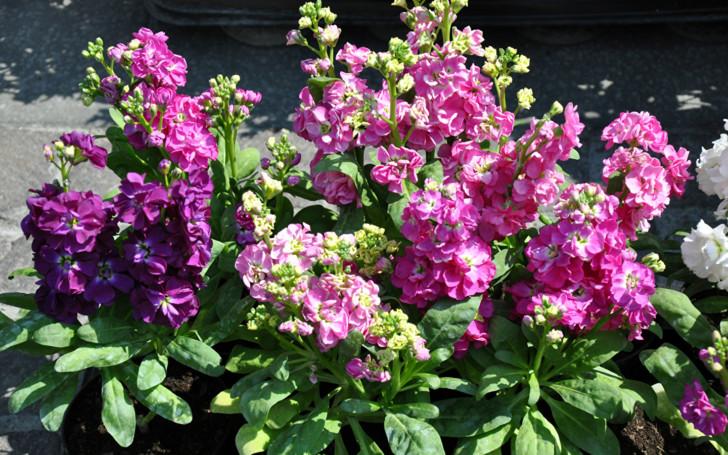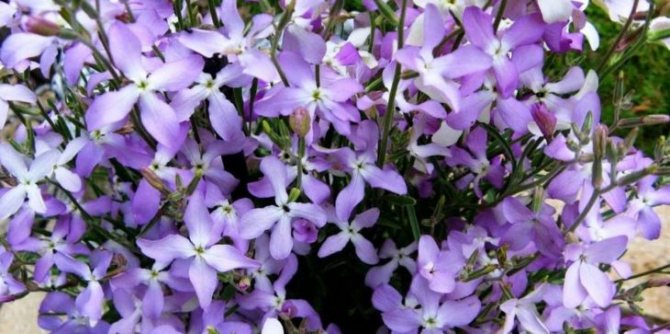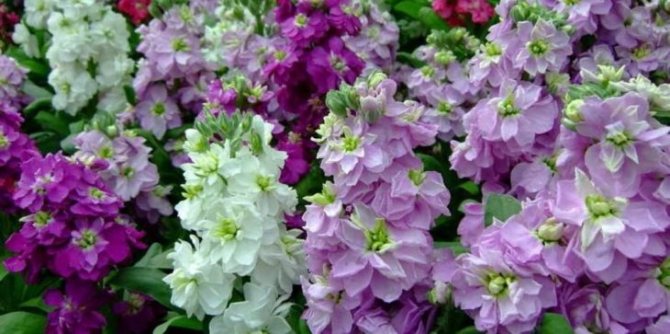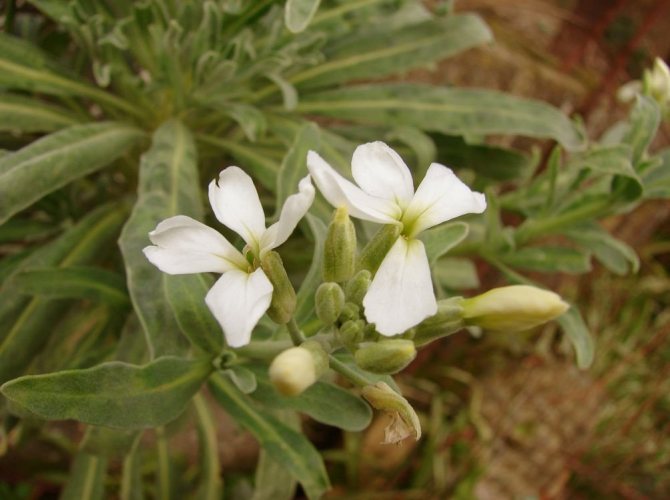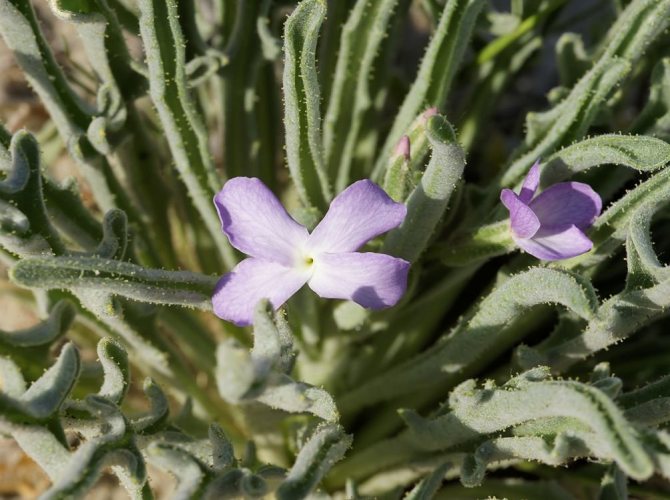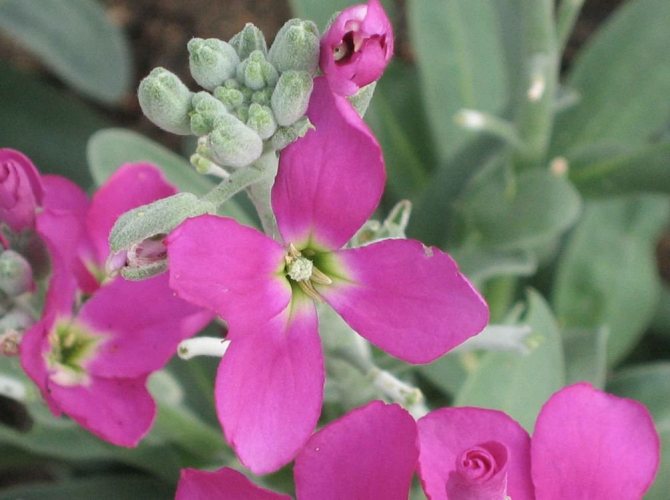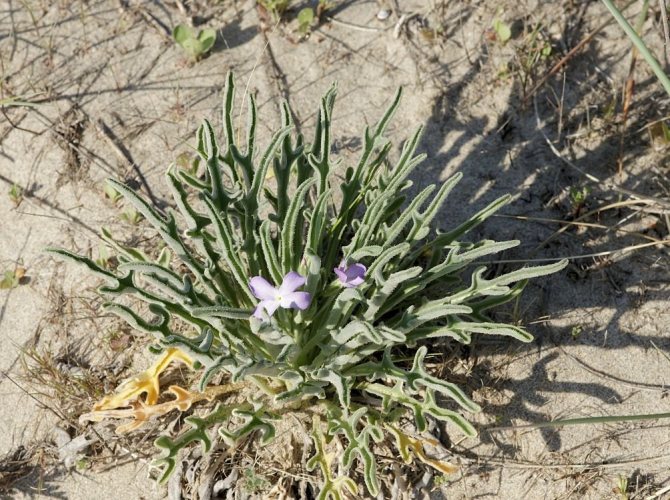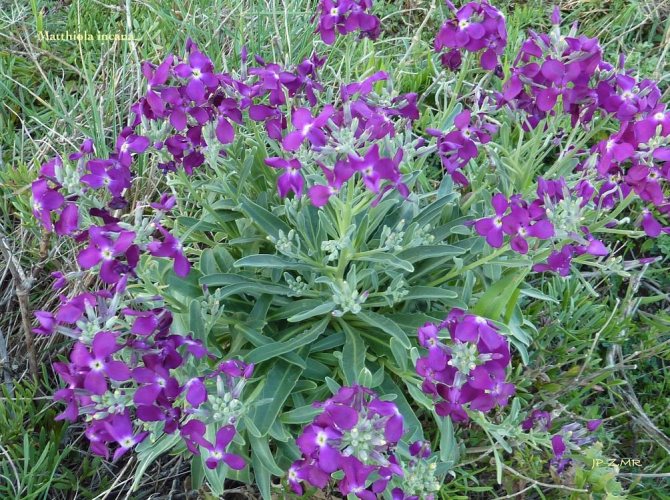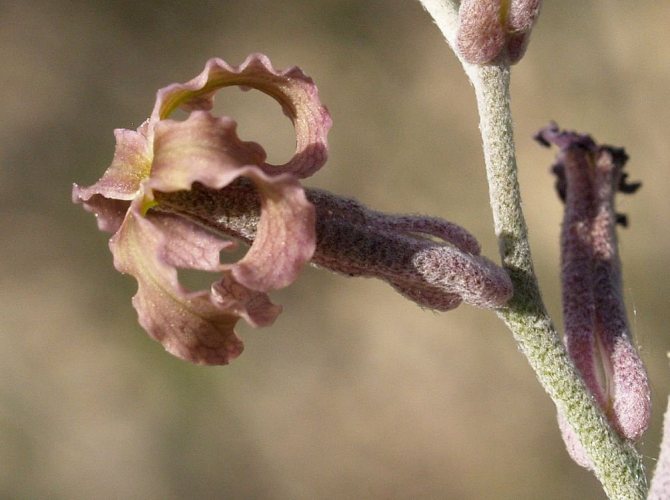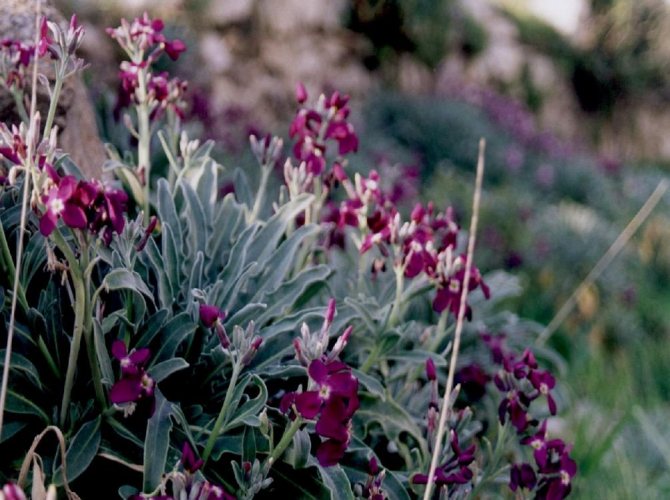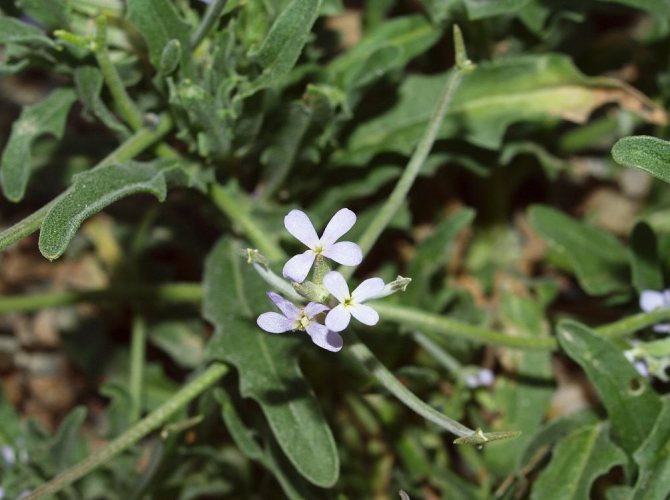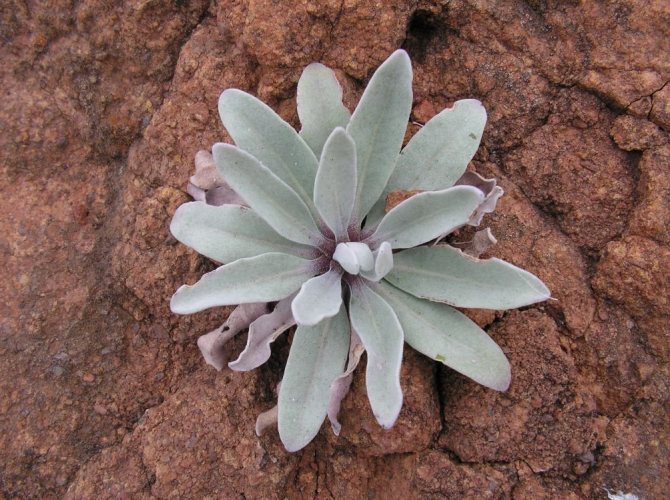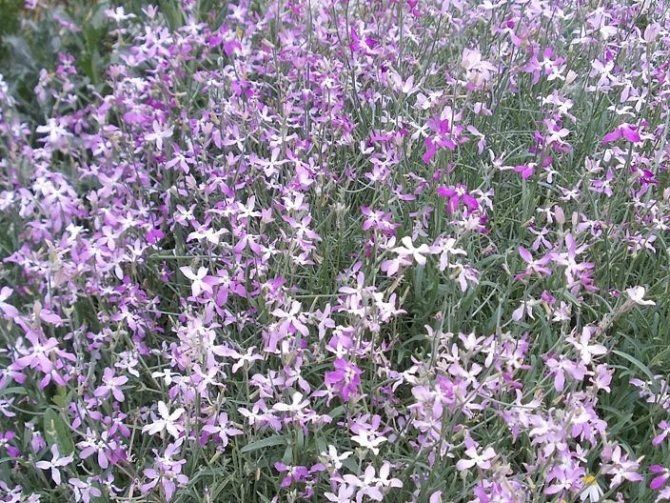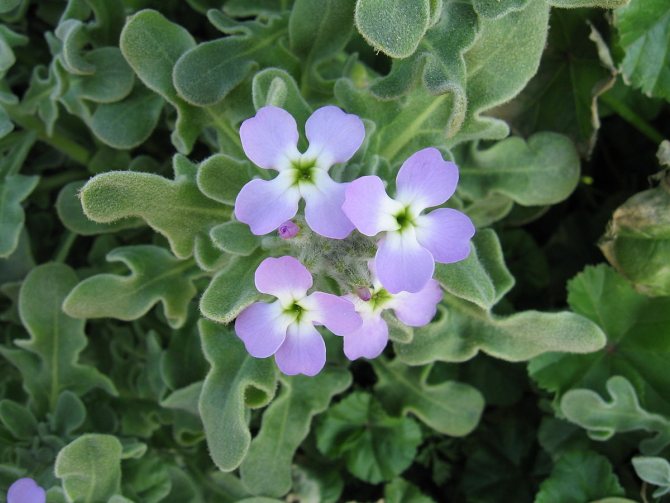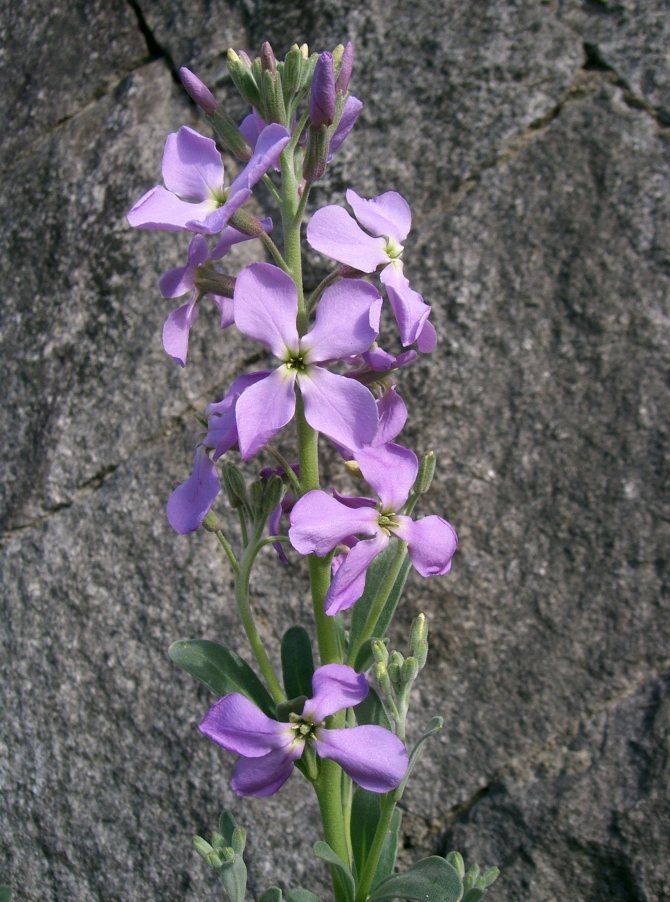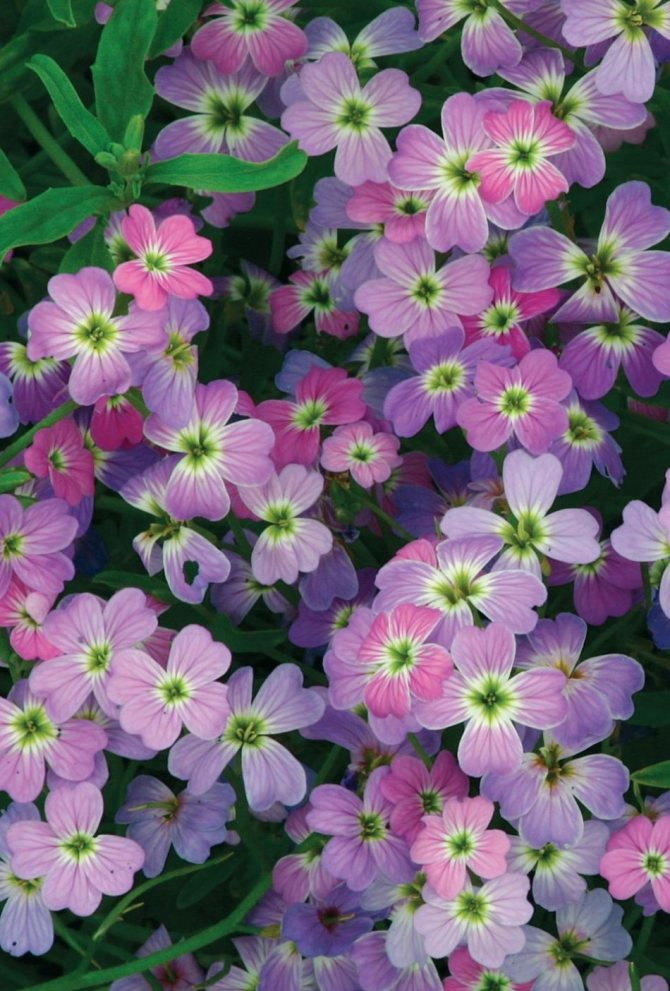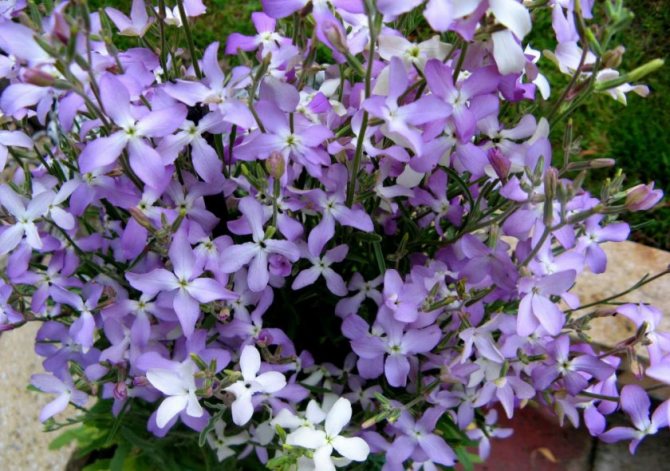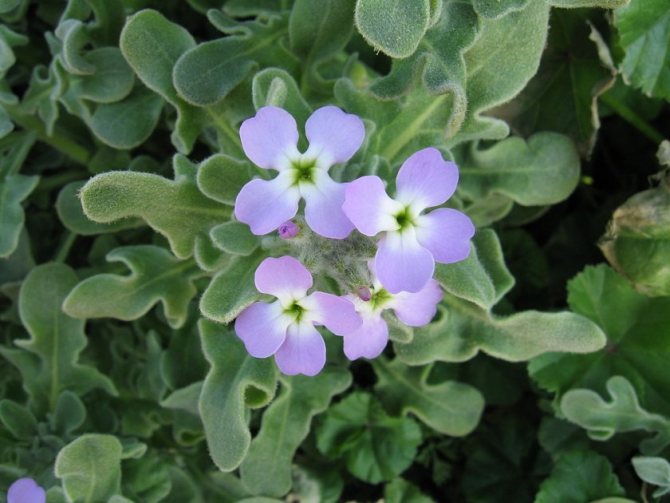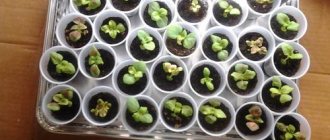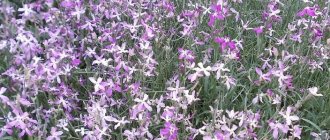Levkoi - annual varieties for the garden
Levkoy gray-haired (Matthiola incana) grows naturally in southern Europe, in the Mediterranean, in Asia Minor and in the Caucasus. In other regions, this beautiful flower does not occur in the wild.
Levkoi are annual and perennial flowers of the Cruciferous family. Mainly cultivated annual varieties of Matthiola, the agricultural technology of which will be discussed in this article.
Levkoy gray
Plants reach a height of 60 cm, tall cut varieties can grow up to 1 m.
The cruciferous family is characterized by simple, four-petal flowers in the form of a cross, pink, white, lilac, red, with a strong aroma. Straight stems of the plant bear successive leaves with pubescence. The stem roots of matthiola are very strong and not very large.
Currently, breeders have bred a huge number of varieties of terry levkoyi. However, there is a certain pattern: for reproduction, seeds are collected from non-double flowers. Double flowers of mattiola are sterile, seeds are not formed in them. After flowering, about 8 seeds ripen in the pod, which remain viable for several years.
Mattiola variety with non-double flowers
It is customary to subdivide Levkoi into groups (there are 10), in which plants are combined according to flowering time, size, cultivation agrotechnology. You can get acquainted with different types of levkoy in the photo. Among them are remontant varieties that bloom twice a year.
Flowers look spectacular in bouquet compositions (Brilliant, Golden Bouquet, Quedlinburg Levkoi and Ekzelzior varieties).
Levkoy for cutting
Fascinating photos of bouquets of mattiola flowers, which give the composition inexpressible grace and airiness.
Application in traditional medicine
Levkoy is known as an antimicrobial, anti-inflammatory, cardiotonic and diuretic. The leaves contain a large amount of essential oil, it is used for headaches and migraines. Seeds are a source of biological steroids, alkaloids. Tincture of leaves and seeds helps with rheumatism and gout.
In this article, we tried to tell in an accessible way about the types of flower mattiola growing from seeds when planting on seedlings and in open ground, methods of pest control, types of feeding.
Mattiola: planting and care in the open field
Levkoi grow well and develop on loose fertile soils, with sufficient moisture and a neutral reaction. The plant does not tolerate waterlogging and high acidity of the soil. For the normal development of matthiola, it is required to set aside bright, sunny places for planting culture.
The plant does not tolerate excessive feeding, it is especially scary to overfeed Levkoi with fresh organic fertilizers.
Advice! Watering is required in moderation, but systematic. It is especially important to monitor the timely watering of the flower beds in the summer heat.
In autumn, plants bloom until the very cold, easily tolerating morning frosts.
It is most convenient to plant matthiola seedlings
Levkoi are planted directly into the ground by seeds or seedlings. In some regions of Russia, when sown with seeds in the ground, flowers do not have time to bloom.
Plant care includes timely removal of weeds and loosening of the soil.Timely feeding is the key to abundant flowering. Levkoi bloom long and abundantly. To prevent the plant from being depleted, it is useful to carry out regular fertilizing with mineral fertilizers. When planting in a garden bed, you can apply a granular phosphorus fertilizer of prolonged action.
Seedling and seedling care
Until the moment of germination, do not water. The container is placed in a dark, warm place (temperature 15 - 20 ° C). Seeds germinate in a week, remove the film, watered with a spray bottle. Further development and growth of seedlings occurs in the light. In order for the stem to develop strong, not to stretch, the plants are kept at a night temperature of 10 ° C, increasing the daytime temperature to 15 ° C.
In the second week, after germination, a pick is made. The stalk of a young Levkoy is very fragile, so moisten the soil, carefully, using a wooden spatula (ice cream stick), remove the plant with a small lump of earth.
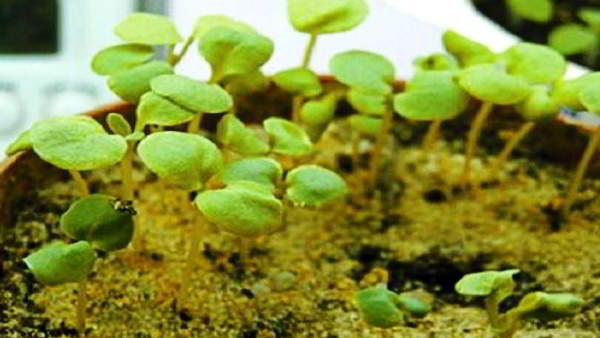
For good development of the root system, a little hydrogel is added to the soil. The dived plants are transplanted into separate containers filled with a 3-component soil mixture. See the section "Soil (composition, characteristics)". Keep in a bright, cool place.
To prevent the plants from experiencing a temperature shock when transplanted into open ground, a hardening procedure is carried out (they are taught to lower the temperature, fresh air). Ventilate the room regularly, open a window, a window. After a few days, take the seedlings outside, gradually increasing the time, protecting them from direct sunlight. Hardening begins 2 weeks before planting in open ground. Water regularly, with the appearance of real leaves, add the first top dressing.
Seedlings are planted on a personal plot at the end of April. Prepared holes or grooves are poured with water to form an earthen slurry. Plants are installed together with an earthen clod or in a peat cup, allow water to be absorbed, sprinkle with earth, tamp well. Low varieties are seated at a distance of 15 - 20 cm, high - 25 - 30 cm.
Reproduction of matthiola: methods and techniques
Annual levkoi reproduce exclusively by seeds, while sowing in open ground or for seedlings in a greenhouse is practiced. The flowering time of plants depends on the sowing time. Distinguish between spring, summer and autumn flowering.
Mattiola seeds
Sowing seeds in open ground is carried out in the spring, when the ground has already warmed up enough. Seeds are laid out in furrows, sprinkled with earth. It will take three months for the seedling to grow before flowering. With too dense seedlings, some of the plants must be removed, using them for transplanting into a free bed.
Advice! The most amazing double flowers come from crooked, twisted seeds. Do not rush to discard seeds of an irregular shape, you can lose lush flowers.
Sowing late varieties makes sense to carry out in a greenhouse for seedlings.
Mattiola sowing seeds for seedlings
In early spring, amateur gardeners begin to plan future plantings, buy seeds, determine the timing of sowing for seedlings, in open ground.
When to plant seedlings
To grow high-quality planting material, it is necessary to sow seeds for seedlings in late March - early April, then flowering will begin in June.
The necessary conditions
Levkoy seedlings are bought in a nursery, in a specialized market, or grown independently, rejoicing in the results of their labor.
Providing a favorable environment, grow healthy, sturdy plants. It is necessary:
- prepare seeds for sowing;
- prepare a nutritious potting soil mixture;
- do not violate the sowing technology;
- adhere to the basic rules for caring for seedlings, seedlings;
- observe temperature and light conditions;
- harden young plants before planting in open ground.
- Observing these conditions, you will get a positive result.
Seed preparation for sowing
When buying seeds, be sure to check the expiration date. Good germination lasts up to 6 years. Overdue ones can give zero shoots. Special stimulating procedures will help speed up their germination.
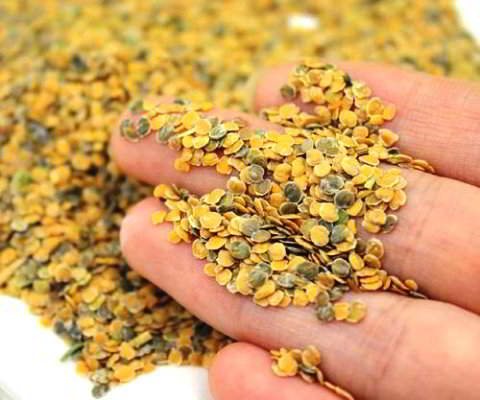

Soak the seeds in water for 24 hours to swell. Floated to the surface, not suitable for sowing, discard. Quality seeds, wrap in a damp soft cloth or a bandage folded in several layers. Put in a cool place with air temperature +4 +5 ° C, for example, in a refrigerator.
Sowing containers
While the seeds are being hardened, containers are prepared. Large ones are needed for sowing, seedlings are transplanted into small ones after picking. The size of the container depends on the amount of seed, there are:
- containers with a transparent lid;
- plastic boxes;
- plastic or wooden boxes.
There should be a sufficient number of various small containers.
It is convenient to use peat cups for planting in the ground, the root is not injured, the seedlings quickly take root in a new place, and do not get sick. You can use the materials at hand.
Soil (composition, characteristics)
Take your potting mix seriously. Novice gardeners buy ready-made "Universal Soil". We recommend preparing a nutritious, fertile soil yourself. Ideal for: black soil, loam or sandy, turf-lined soil.
For germination and emergence of seedlings, seeds are sown in a mixture consisting of 3 parts of turf and 1 part of sand.
After diving, the seedlings are transplanted into pots filled with an earthen composition of sand, turf and leafy soil. Leafy soil, not as nutritious as turf, but light, loosens it well.
Levkoi - tenderness in combination with other plants
The curly flowers of annual levkoy are in perfect harmony in flower beds and ridges with other summer houses. The combination of multi-colored flowers with lavender, rosemary, decorative wormwood, mignonette is especially interesting.
Mattiola in the flowerbed
Quite good combinations are obtained by planting matthiola next to perennial phlox, pyrethrum, and daisy. Interesting compositions are obtained by planting plants next to decorative deciduous plants and herbs (thyme, thyme).
How and where to plant Mattiola in the garden
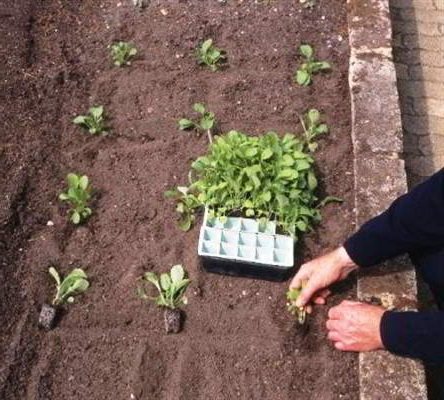

How to plant matthiola in the ground
Choose a well-lit, open area for planting. It is advisable that no other representatives of the Cruciferous family were previously grown in this place, since the soil can be infected with fungal infections and pests.
Transfer the seedlings along with the earthen clod to the depth of the root system. Observe a distance of 20 cm between the bushes: if planted very densely, a black leg injury is possible. Better to plant in the evening or in cloudy weather. The soil needs fertile, loose, neutral reaction. Heavy soils are destructive.
Mattiola: photo
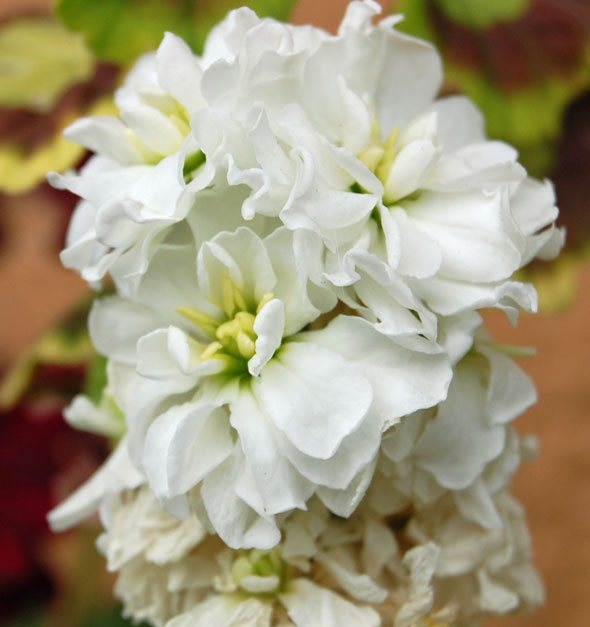

Mattiola is an outdoor plant that comes in a wide variety of varieties. Among them, you can find both perennial and annual crops. The flower is famous for its delicate and delicate aroma. The peculiarity of the plant is that the opening of the buds occurs in the evening. Planting and caring for matthiola does not require much experience, so even a novice gardener can grow it.
Mattiola in landscape design
The flowers have a strong, pleasant aroma that intensifies at night. Levkoy is usually planted in special compositions with fragrant flower crops.
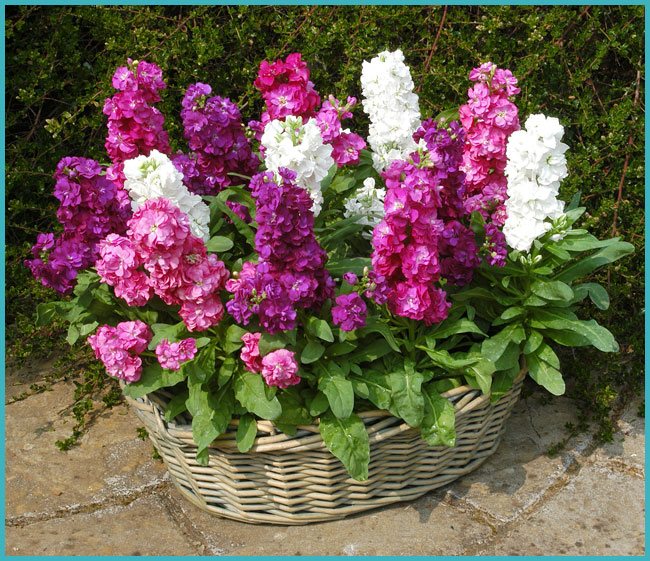

Mattiola also looks good in flowerpots
The plant is suitable for growing in a pot culture and flowerpots. Low-growing varieties of mattiola are used in landscape design for the decoration of rock gardens, pools and ponds.
Description and varieties
Mattiola includes about 50 different types of flowers. But in domestic efforts, only two-horned and gray-haired matthiola are grown.
Two-horned
Plant height reaches 50 cm.It is characterized by thin and creeping stems and fluffy foliage. This species is able to withstand frost, so you can plant seeds directly in open ground without first growing seedlings. It is worth planting a plant near dense crops. Most often, the two-horned mattiola is located along the paths, summer pavilions. It will also be interesting to see how they look. Thus, while walking in the garden, you can enjoy the incredible aroma.
Mattiola Two-horned
An area with diffused sunlight is perfect for this type of plant. It is unpretentious in leaving. The inflorescences are pink or light lilac in color. The buds bloom only in cloudy weather or in the evening. It is the two-horned matthiola that is called the night violet. She has her own varieties, each of which has its own external differences.
Evening scent
This type of two-horned matthiola has purple flowers. The height of the bush reaches 45 cm, the stem is highly branched. The evening scent is characterized by abundant bloom and intense aroma. And here is what Tuberose scent looks like, you can see
In the photo - mattiola evening aroma:
Mattiola Evening scent
The plant has an erect stem and loose racemose inflorescences. This variety of two-horned matthiola is the most common among gardeners. And this is due to the pleasant aroma that the delicate lilac flowers emit.
star Light
This type of two-horned matthiola is presented in the form of flowers of various colors. The height of the bush reaches 40-50 cm. When the buds bloom in the evening, the street is filled with an incredibly rich aroma. The flowers of this culture do not differ in their beautiful appearance, but are valued for their aroma.
star Light
The variety is used when creating mixborders, ridges and borders. Planting seeds is preferable near a bench or under windows to enjoy the scent.
Night violet
This plant is characterized by racemose airy inflorescences, consisting of delicate flowers. They can be used when decorating flower beds or balconies. The height of the bush is 30 cm.
Night violet
The aroma of the night violet is sweet and incredibly pleasant. But you can enjoy it only in the evening, but in the afternoon the flowers curl up and become lethargic.
Lilak
This type of two-horned matthiola is a cold-resistant, light-loving plant. Its peculiarity is a densely branched stem. Leaves are linear and coarsely toothed. The height of the bush reaches 50 cm. The buds are small and located in loose racemose inflorescences.
The flowers are small in size, they are closed during the day, but with the onset of evening they bloom and give others a charming scent. This variety is used in the design of the Mauritanian lawn and combined ridges.
And here, and how to do it yourself, is indicated in this article.
How Gaillardia large-flowered herbaceous plants for open ground looks like, you can look at this
It will also be interesting to know how the seeds of Coreopsis perennial are planted:
Gray-haired
This type of matthiola can have one or more stems. They are of the branching type. The bloom is terry, bright and beautiful, compared to Matthiola two-horned. But her scent is not so outstanding. Levkoy is grown by seedlings.
On the video - the cultivation of Mattiola:
How to grow seedlings correctly
Usually the flower is not bred with seedlings, it is better to grow matthiola from seeds. The flower has weak roots, it does not tolerate transplanting well. However, if the gardener wants to get great aromas already at the beginning of summer, then it is better to use a seedling technique.
Before sowing seeds, you need to prepare containers and soil. The soil is used nutritious, loose, with excellent water and air permeability. Containers and soil must be treated with potassium permanganate.
Planting rules for matthiola:
- The seeds are sown in early February.Another sowing is carried out in March, then mattiola will bloom at different times.
- Since the seeds are quite small, they are scattered over the prepared soil, keeping a distance of at least 4 cm, and sprinkled with earth a little. It is not necessary to deepen the seeds. Carefully pour over them with warm water, cover with glass or film.
- You need to place containers in the sun. Before the first shoots appear, it is better not to water.
To grow seedlings from seeds, special conditions are required. When the first shoots appear, it is necessary to create excellent lighting and reduce the temperature to + 12 ° C, otherwise the seedlings will stretch upwards.
If the seedlings are grown in boxes, then they need to be dived every 2 weeks. Keep in mind that with all care, some of the seedlings will die.
To minimize the risk of root damage, the soil must be well shed before planting. Each plant is carefully taken out, trying not to injure the delicate roots. In the container where we will transplant the plant, we make a hole, put the seedling and cover it with earth until the cotyledon leaves. So that the seedling can immediately contact the ground, we squeeze the soil around a little. After that, the plant must be watered.
Professional florists who have been growing Matthiola for several years grow seedlings without diving. A box of eggs or chocolates is perfect for this. After filling the cells with soil, plant 2-3 seeds in a separate hole. As the seedlings grow, they leave one sprout, the strongest.
They plant a flower in a permanent place without destroying a lump of soil as soon as the warm time of the day comes. This is most often done in late spring - early summer. The planting is carried out, observing a distance of 15-30 centimeters, it all depends on the variety. In order for the plant to take root faster, it must be shaded.
Conditions for sowing seeds directly to the garden:
- The earth is spilled with potassium permanganate, loosened and grooves are formed with a depth of no more than 0.5 cm, otherwise the sprouts may not break through to the surface.
- For even distribution of seeds, they are mixed with sand in equal proportions and scattered into the furrows.
- Fall asleep with earth by 0.5 cm. Do not tamp, you just need to sprinkle the soil with water a little.
Night violet, which is sown in autumn or spring, emerges in late May - early June.
How to choose a landing site
So that the plant grows healthy, does not stretch in height, it is planted in an area where there is enough sunlight. When disembarking, matthiola must be protected from the wind. Observing these conditions, you can be sure that the plant will grow in a short time, give brushes and delight you with a wonderful smell.
If we talk about the earth, then it should be loose and fertile... However, it is not recommended to fertilize the plant with manure, since it may contain phytophthora spores. The plant grows well on loamy and sandy loam soil... The acidity of the soil should be neutral.
It is not advised to plant a night violet in a place where representatives of crucifers grew before. This can provoke a plant disease with keel or fungus.
The soil must be prepared in the fall. Digging makes it possible to prevent fungus or black leg. The earth needs to be dug at least 40 centimeters deep. You can dig up while adding manure to the soil.
How to properly care for seedlings
Mattiola two-horned will grow up healthy even among amateurs, if you follow all the rules of planting and caring for her.
- When 2-3 leaves appear on the plant, the plants dive. You need to leave a distance of 15-35 centimeters between the sprouts. It is also necessary to take into account the peculiarity of growth. Tight seating can cause fungus to develop.
- Mattiola loves watering, but does not tolerate waterlogging, the rhizomes can rot. Weeds must be removed immediately after emergence. They can weaken plants as well as provoke the appearance of fungus.
- After watering, it is imperative to loosen the ground so that air can penetrate to the roots.
- Faded inflorescences must be removed so that they do not absorb nutrients.
- Matthiola needs to be fed after planting. Usually, nutrient mixtures for indoor flowering plants are used for this. The first time feeding must be done 3 weeks after planting in open ground. It is especially necessary to feed the plant during the period of bud formation and flowering.
Landing in open ground
If you live in the southern regions, then you can abandon the seedling method of growing and send the seeds directly to the open ground.
Preparatory activities
To obtain planting material, it is necessary to select yellowed pods in winter.
They can be cut or plucked out along with the root. Get bunches out of them and hang them in a carefully ventilated room.
Only remove the seeds from the pods when they are completely dry. Before sowing, clean them and treat them with potassium permanganate. This will prevent the development of disease.
Sowing time
Sowing method
Before sending seeds to the soil, it needs to be prepared. To do this, dig up and fertilize the site. Dig holes 3 cm deep.
Place them at a distance of 10 cm. Do not add organic matter to the soil before the sowing process, since Matthiola will not fully develop. Do not plant the plant in the same place, de cruciferous plants grew earlier.
The area chosen for sowing must be carefully lit.
Mattiola two-horned, evening aroma, two-horned mix
When to plant seedlings
Mattiola two-horned or night violet is one of the most popular flowers among summer residents. With her extraordinary aroma, she invites you to the gazebo for an evening cup of tea or sit on the porch, look at the stars, listen to the songs of a cricket. When to plant seeds for seedlings?
To get early flowering, seeds are planted for seedlings in March. The best germination will be on loamy, sandy soils. But, in principle, the plant is not whimsical, it will grow everywhere with regular feeding. Strongly grown plants do not tolerate transplanting well, so many people prefer to sow seeds directly into the ground.
When growing seedlings, they adhere to the basic rules:
- compliance with the temperature regime (+12 + 15 ° C), when seedlings appear, the temperature drops to + 10 ° C;
- moderate watering;
- prevention of black leg disease;
- when 2 true leaves appear, dive, transplant into single containers;
- 2 weeks the seedlings are hardened;
- a plant with five leaves is transplanted into the ground.
For planting seedlings, sunny areas are chosen, in the shade the night violet is strongly stretched, lies down. The selected location must be dry, without stagnant water.
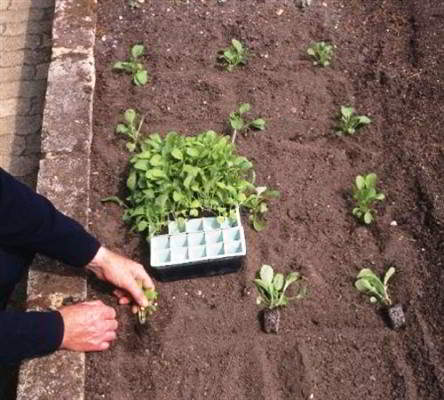

Seedling method
If you want to bloom in June, you must use the seedling growing method. It is necessary to plant seeds in containers at the end of March or April.
Soil and seed preparation
The soil and containers must be prepared 2 days before the upcoming planting. In this case, the following simple rules must be observed:
- Treat the box for planting with a solution of potassium permanganate
... Then dry thoroughly. Such actions will allow you to disinfect the container, eliminating all harmful microorganisms. - Place some pebbles at the bottom of the box, which will act as drainage.
- Collect the substrate in the box, which will consist of sand and turf. Take them in a ratio of 1: 3.
- Pour water over the soil with a slight addition of potassium permanganate.
To speed up the germination of seeds, you must first soak them in boiling water. Withstand them for a day, and then put in a damp cloth. Place in the refrigerator for another day.
Bright mattiola (another name for this plant is levkoy) will adorn any flower garden.Timely and correctly carried out planting of Levkoy in open ground and competent care for it will allow you to admire the wonderful flowers and enjoy their aroma throughout the season.
Flower care (watering, feeding)
Leaving is carrying out regular activities:
- weed control (weeding);
- loosening row spacings, holes;
- watering;
- top dressing;
- pest control;
- prevention of disease.
Levkoy does not tolerate waterlogged soil, mulching the rows to retain moisture is not recommended. Watering is carried out if necessary to prevent wilting of foliage and inflorescences.
In the process of watering, the plants are fed. Mineral fertilizers are used, during the flowering period - phosphorus-containing, potassium fertilizers. As a top dressing "Biohumus" is used, accelerates budding, increases immunity. A drug that reduces stress during transplantation - "Multiflor Aqua". "Stimul" has a general strengthening and stimulating effect.
Description of the plant
Levkoy is a small shrub or herbaceous representative of the extensive cruciferous family. This unpretentious plant is often found in flower beds. The average height of Levkoy is from 20 to 80 cm, however, there are “babies” about 15 cm in size and “giants” with a height of under 100 cm. Among the numerous varieties of Levkoy there are plants with a short one- or two-year development cycle, as well as perennials. Matthiola has branched straight stems and greenish oblong leaves. Simple and double levkoi attract attention with a variety of shades of bright spike-shaped or racemose inflorescences - there are white, yellow and light blue, various shades of pink, purple, red and lilac. Flowers come in diameters from 3 to 7 cm. The highlight of mattiola is the amazing aroma that flowers exude in the evening.
Mattiola gray
This is a real decoration of the garden. It is not as aromatic as Matthiola bicorno, but the color palette is so rich that it has become a priority.
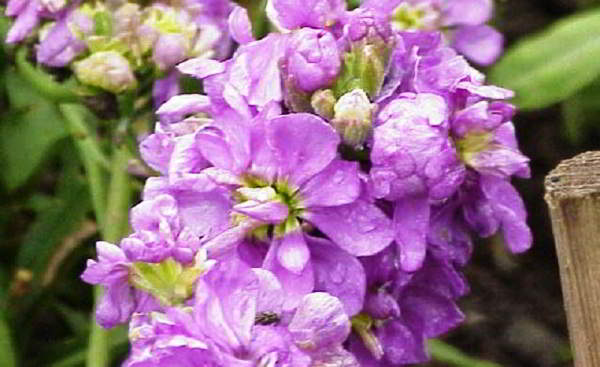

Gray-haired Mattiola is different:
Stem shape: straight, branched.
The size (15 - 80 cm) of the bush:
- dwarf (20 - 30 cm);
- medium (from 45 cm);
- tall (60 - 80 cm).
Flowering period:
- summer (from July);
- autumn (mid-August - September);
- winter (blooms in the 2nd year after sowing, April - May).
Each variety has its own characteristic features. Considering these features, landscape designers create real garden masterpieces.
Based on the flowering period (July - September), varieties differ:
- early;
- medium early;
- medium;
- late.
You definitely need to know what the inflorescence will be: spike-shaped or racemose; its filling, how many flowers (simple, double). Size - large, small (3 cm or more). Color: lavender, soft coral, burgundy, burgundy.
- Dwarf. Only 20 cm, the color is double, the dark shade turns into white.
- Dwarf. Gorgeous decoration of the balcony. They are planted in garden containers, ridges, along the curbs.
- Sort Sugar with spices, double inflorescence - 50%.
- Prestige brand, cold-resistant, long-blooming, fragrant, terry up to 60%.
Medium-sized
- Kats (apricot, yellow). It blooms very early, height up to 64 cm, used for mixborders, compositions, bouquets.
- Swing (brand Gavrish). Flower size up to 5 cm, blooms from June to September, well worth in a bouquet.
- Vintage, color peach, lilac, pink, copper, burgundy. Height 50 cm, flower 5 cm, terry more than 50%, late flowering.
Tall Levkoe
Reach 80 - 100 cm, beautiful in bouquets, flower arrangements.
- Lucinda, blooms for a long time (June - October), flower diameter 7 cm, brush inflorescence.
- Opera Francesca. Very aromatic, blooms for a long time, abundantly.
- Liverpool. Blooms late, single stem, loose cluster inflorescences, snow-white flowers, grown in a greenhouse in the autumn-winter period.
Varieties
There are more than six hundred varieties of mattiola. Gray-headed and two-horned levkoi are the most common species.
- Gray levkoy is a plant up to 70 cm high, with a branched lignified stem and numerous inflorescences. Mattiola of this species begins to bloom in June and pleases with exuberant colors until November.
- Two-horned matthiola, which is called "night violet", attracts not by its appearance, but by its unique night aroma. It is a sprawling herb up to 50 cm high with simple lavender flowers.
Terry and simple varieties of matthiola have several differences. Matthiola with regular flowers can be propagated independently by collecting ripe seeds. Terry modifications of Levkoy cannot do this, they are sterile and do not form seeds. "Shaggy" hybrids are more expensive. They are more difficult to propagate, and they bloom longer and have a more decorative appearance.
It is interesting!
Levkoy seed packets often indicate the coefficient of terry. This indicator determines what percentage of plants will be with double flowers. Mattiola of the same variety can produce different flowers at the same time.
Plant characteristic
Flowers of Mattiola bicorno are grown in an annual planting. The plant is quite unusual and has many differences. Its features:
- Matthiola has a straight or spreading stem, it depends on the variety. There are many shoots on the flower, they, like the foliage, have a dense fluff;
- the flower is quite tall, with proper care it can grow up to 60 centimeters;
- large teeth are clearly visible on bright green leaves;
- the plant has inflorescences in the form of brushes, they do not differ in the brightness of the color range. In addition, the flowers are very small;
- in the daytime the flower "sleeps", flowers bloom in the evening, spreading a pleasant smell;
- Mattiola blooms for a long time. If you plant flowers early, then flowering continues from the beginning of summer until the first frost;
- small seeds ripen in pods. The seeds retain their germination capacity for up to 3 years.
Varieties of matthiola
In nature, there are more than 50 varieties of matthiola. The people call the plant a fragrant violet. Most often, gardeners plant only two varieties on their site: Mattiola two-horned and Mattiola gray, it is also called levkoy. Breeders have developed many varieties of matthiola, which differ in color and aroma.
The most popular varieties of Mattiola bicorno, which are planted in flower beds:
- Evening scent... Differs in a large branching of straight processes. The plant grows a little less than 50 cm, inflorescences are small, pleasant lilac color, with a pronounced odor;
- star Light... This is a varietal mixture. Flowers of various shades bloom in the flowerbed. Flowers have a straight stem. No more than half a meter high. Since each variety has its own aroma, then, intertwining with each other, they will give the gardener a real fairy tale. This mixture is best planted near the house;
- Mattiola pink (night violet). It is grown most often on balconies. Plant height is no more than 30 centimeters. Flowers of a pleasant lilac shade, similar to a brush, have a sweet scent.
- Leelato. This plant is resistant to cold weather, but loves sunny places. The height of the plant is no more than half a meter. The smell of this variety attracts with its softness and originality.
- Summer evening... This variety is most often grown by gardeners. The flower grows up to 50 cm, the inflorescences are collected in a tassel, have a lilac color. The smell is persistent and memorable.
When to sow levka and plant seedlings?
To increase germination, matthiola seeds are pre-soaked in warm water for a day. When they swell, stratification is carried out: the inoculum is wrapped with a damp cloth and placed in the refrigerator for a day (not in the freezer!). Seeds hardened in this way can be sown.
Seed propagation can be organized in two ways.
Method one: pre-grow seedlings
This method will help to obtain early flowering specimens of matthiola. With this cultivation, work begins from the beginning of March to the end of April.
- The bottom of small containers with drainage holes is filled with expanded clay or fine gravel.
- Loose soil is prepared: take one part of sand, two parts of leafy soil and one part of turf. You can use ready-made soil from specialty stores, choosing soil with neutral acidity. The soil is pre-watered with a weak pale pink solution of potassium permanganate. This is a good prevention of a dangerous fungal disease - black leg, which can lead to the death of young plants.
- The seeds are deepened by half a centimeter into the moistened soil, observing the interval between adjacent specimens a little more than a centimeter.
- Containers with matthiola are covered with glass or plastic wrap, kept in the shade at a temperature of about 20 degrees.
The first shoots will appear in about 5 days. After that, the seedlings are placed in a cooler and moderately sunny place, and the glass is removed. Young Levkoi do not like temperatures above 15 degrees. The first watering is carried out three days after the emergence of sprouts. After half a month, the plants dive into small separate cups, always placing a drainage from expanded clay or fine gravel at the bottom of the container.
When two true leaves appear on young flowers, fertilizing is carried out with mineral fertilizers. In a liter of water, 0.1 g of manganese sulfate and zinc are diluted, 0.3 g of boric acid and copper sulfate are added. At the initial stage of development, plants are watered moderately, preferably in the morning.
Before planting in open ground, the seedlings must be hardened for about a couple of weeks. Young seedlings are gradually accustomed to fresh air, constantly increasing the time spent walking at an open window. Planting is carried out in May, in warm regions - in April, when four true leaves appear on matthiola. Seedlings overexposed in cups take root less well, give less side shoots and flowers. It is best to plant in open ground in cloudy weather or in the evening, so that delicate sprouts do not suffer from sunlight.
Choose a site protected from the wind and diffused sunlight and fertile loose soil. It is important that representatives of the cruciferous family, such as cabbage, horseradish or radish, do not grow in this place last year. The distance between neighboring plants is from 15 to 30 cm, depending on the type of mattiola. Wells moisturize well, after planting they compact the soil.
You can get levkoi that bloom throughout the summer-autumn period. For this, from the end of February, Matthiola is sown approximately every three weeks. Another option is to use different varieties of this plant for growing from seeds at the same time.
Method two: sow in open ground
This method is best used for early varieties, because it usually takes more than three months from the moment of sowing to the beginning of flowering of matthiola. Levkoy is sown on lawns from the end of April. In this case, the first flower stalks will appear only in August.
You can sow Matthiola outdoors at the end of winter. For this, grooves for plants are prepared in the fall. The seeds are not soaked, but placed at a distance of about 8 cm from each other in prepared holes, covered with dry sand and covered with snow. Amicable shoots appear in May, flowering in such hardened specimens is early and abundant.
Mattiola two-horned
One-year-old. A modest flower with extraordinary magic. Branching stems grow up to 30 cm, covered with thin linear leaves. The flowers are small, of various shades of lavender, lilac shades, reminiscent of lilacs. In the evening, they emit a rich, bright aroma. They close during the day, bloom after sunset, in cloudy weather.
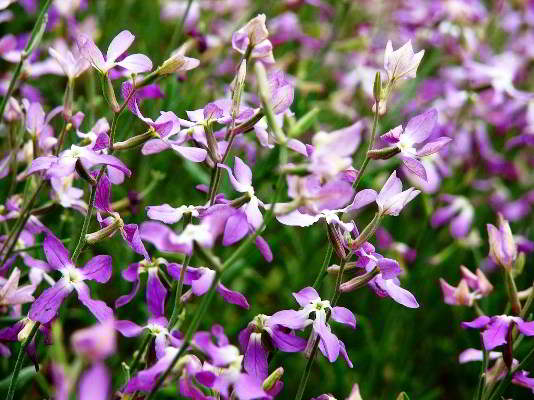

Flowering is short, lasting for several days. Fading plants, fruits are formed - a long pod filled with ripening seeds. Drying, it bursts, forming self-seeding. Loves the sun, in the shade the stems stretch out, lie on the ground, tolerates the first small frosts well.
Varieties without striking differences, they are usually mixed. Stem height 30 - 50 cm. On sunny, fertile areas, they form fluffy, branched plantings.
Features of care after disembarkation
Levkoi are unpretentious, but prefer sod-loamy or sod-sandy soil, grow poorly on acidic soil. Both a sunny area and partial shade are suitable. The plant needs moderate watering. In dry times, humidification is carried out more often, but irrigation is not abundant. Additional care consists in the timely loosening of the soil. The procedure is carried out carefully, as Levkoy have fragile stems. You also need to regularly remove weeds in the area with matthiola.
- Fertilizer
Levkoi do not need organic feeding. Before planting the plants, you can add wood ash to the water for irrigation. Mineral fertilizers are applied to the soil 4 to 8 times per season, depending on the fertility of the soil. It is especially useful to feed with complex phosphorus-potassium fertilizer before flowering - this will increase the number of inflorescences and buds.
- Pests and diseases
Loose soil and the absence of waterlogging are good prevention of fungal diseases.
In dry and hot weather, Levkoi can suffer from attacks by cruciferous flea beetles and other insects. If there are few pests, it is enough to powder the flowers with wood ash powder. In case of a massive attack, insecticides are used, for example, "Aktara" or "Aktellik" according to the instructions.
- Post-flowering care
Matthiola seeds ripen in September or October. The cut off ground part of the plants is dried in a dry and ventilated place, and then small seeds are collected.
Levkoy is usually grown as an annual, but in the southern regions, perennial varieties of Mattiola can be preserved. To do this, the ground part is cut off, the plant is covered and mulched. In regions with colder climates, the flower is sometimes dug up before the onset of cold weather and transferred to a warm place for the winter.
Miniature Levkoy varieties can be grown in a pot culture. Plants bloom magnificently in flowerpots all summer and autumn, before the onset of cold weather. If matthiola is transferred to a light windowsill before frost, then at a moderate temperature it will bloom in winter.
Levkoy can become a wonderful decoration for any flower garden. From a wide variety of varieties and hybrids, you can always choose a suitable plant for decorating curbs, alpine slides and lawns. Some varieties of this versatile flower are used for cutting and grown in pots. Unpretentiousness, beautiful appearance and wonderful evening aroma help mattiola to remain popular with flower growers.
Mattiola is a herbaceous flowering plant that came to us from the Mediterranean. It belongs to the Cruciferous family. The appearance of mattiola is rather modest, but the aroma of its flowers is so beautiful that it is often because of it that the plant is given a place in the flower garden. They planted it closer to the gazebos, terraces or windows of the house. Since the flowers open at night, matthiola is often called "night violet" or "levka".
Diseases and pests
Like any other plant, levkoy affects diseases and insects. To a greater extent, the flower is susceptible to:
| Disease | Signs | Treatment and prevention |
| Keela Cruciferous | In the early stages, it is difficult to identify. On the roots, spherical or fusiform growths of small sizes appear, matching the color of the rhizome. Over time, they grow, turn brown and move to the aboveground part. The buds will soon decompose and infect the soil. Fungal spores persist in the ground for up to 10 years. When defeated, it lags behind in development. The aboveground part withers, turns yellow. | It is impossible to cure. Affected specimens must be destroyed and the soil disinfected. To avoid the disease, you need to follow the rules when planting. When watering, do not overmoisten the substrate. |
| Blackleg |
| The plant will die anyway.It needs to be destroyed, the ground should be treated with HOM to prevent contamination of other bushes after planting. |
| Cruciferous flea |
|
|
Description of the plant
Mattiola is an annual or perennial crop with herbaceous branched shoots 30-90 cm high. Dense, straight stems quickly lignify. They are covered with bare or densely pubescent dark green skin. Matthiola growth consists of a large number of soft leaves. Dark green lanceolate foliage with a solid or scalloped edge, concentrated at the base and at the bottom of the shoot.
Already at the end of spring, dense racemose inflorescences bloom on the tops of the stems. They consist of simple or double flowers with soft, rounded petals. The color of the inflorescences can be pink, white, lilac, purple or yellow. Flowers bloom at sunset and are pollinated by nocturnal insects. The air next to the flower garden is filled with a rich sweetish aroma. Plants are excellent honey plants. After pollination, the fruits ripen - small flattened pods. Each contains many round-shaped seeds. The seeds turn brown or black.
Description
It is an annual or perennial herb, reaching 0.3-0.9 m. The stem is compacted, erect, strongly branching. Covered in the finest leather: bare or short-haired. Lanceolate sheet plates are solid or with teeth around the perimeter. Hairy and soft to the touch. In the root area, they are collected in fluffy rosettes.
In the last days of May, cluster-like inflorescences appear from ordinary or double buds. The petals are round, of various colors: snow-white, violet, lilac, crimson, blue, lemon. The odor emitted attracts pollinating insects
After the end of flowering, fruits appear instead of buds. These are flattened pods containing a large number of small seeds.
Types of matthiola
The genus Matthiola includes about 50 main species. On their basis, more than 600 decorative varieties have already been bred. Plants can be divided into groups by height (dwarf, medium, tall), flower structure (simple, double) and other characteristics. Some of the most popular matthiol are as follows:
An annual with a thin, highly branched stem forms a spherical bush about 50 cm high. Shoots are covered with gray-green petioled foliage of a linear shape. In June-August, dense paniculate inflorescences with simple corollas consisting of four petals bloom. They are colored light pink or lilac and give off an intense, pleasant scent. After pollination, small oblong seeds ripen in small dense pods.
An annual plant with weakly branched shoots 20-80 cm high. The stems quickly become lignified. They are densely covered with oval or narrow-linear foliage with short pubescence. Plain or double flowers are collected in dense inflorescences at the tops of the shoots. They are colored pink, white, blue, lilac, yellow and deep purple. This species of Levkoy blooms in June and keeps flowers until the first frost. In the south, it can bloom even in winter. The fruit, a flat, multi-seeded pod, ripens only in varieties with simple flowers.
The height of a perennial herb is 20-50 cm. Its stems and leaves are colored dark green and covered with a long tomentose pubescence of a silvery shade. The foliage forms a dense basal rosette. Sessile leaves are oblong. In May-June, a loose racemose inflorescence of simple yellow-brown flowers blooms. The buds open at sunset and exude a characteristic strong scent.
Popular varieties
The most popular varieties of night violets, which most gardeners show off on their site.
Vintage
Terry variety, which is recommended for breeding in regions with cool climates. It can grow in height by at least 40-50 cm. The leaves are dark green, oblong in shape. They have dense inflorescences in the form of a brush of a delicate pink hue. Flowering lasts for 30-45 days. The number of inflorescences is regularly renewed due to growth and the appearance of numerous lateral shoots.
Cinderella
An annual low-growing plant up to only 20 cm high. The stem is strong, branched. Lanceolate leaf bright green color. The variety is distinguished by the presence of large double flowers, collected in large, dense, high-lying inflorescences in the form of brushes. They have a varied palette of shades.
Bouquet Katz
A tall variety, capable of reaching more than 80 cm. The stem is dense, moderately branching. The bushes are decorated with dark leaves of an oblong shape and large size. It has large double inflorescences of various shades, from white to purple. As the name suggests, it is used exclusively for cutting.
Harmony
An annual undersized variety, representatives of which are only 15-20 cm tall. The leaves are small, the stem is strong, moderately branched. Terry inflorescences, located at the top of the peduncles.
Rich flavor
The cultivar is medium in size, has bright small leaves and a sturdy stem. It is valued for its double flowers, collected in inflorescences and located at the top of the plant. Has a spicy aroma.
Lilac
An annual plant grows to a maximum of 50 cm. The trunk is strong, erect, branches abundantly. The leaves are large, serrated along the edges. The racemose inflorescences have a lilac shade of flowers. The flowering period is at least 2 months and begins on average 60 days after sowing.
Appleblossom
Low-growing terry variety with a height of only 20 cm. It has a persistent straight stem, on which grayish-green leaves are abundantly located. Inflorescences at the top of the peduncles of various pastel shades.
Summer evening
Annual culture up to 50 cm high. The flowering period is only 1 month, pleases in the last decade of June. Sprawling branchy stem. Inflorescences in the form of lilac brushes.
Evening scent
Perennial, characterized by the most pleasant aroma, capable of spreading over large areas. The bush is small, reaches 45 cm in height. The stem is branched, erect. The racemose inflorescences consist of lilac flowers that open and exude aroma only in the evening. They are distinguished by abundant flowering.
Growing Levkoy
The main way of reproduction of matthiola is sowing seeds. In the southern regions, it is possible to sow directly into open ground. This is done in November or April in an open, sunny area. They try to evenly distribute small seeds into shallow grooves. It is better to mix them with sand beforehand. When the seedlings form 3 true leaves, they are thinned out so that the distance is 15-20 cm.
To get flowering plants as soon as possible, it is recommended to pre-grow seedlings. At the beginning of March, seeds are distributed into containers with a mixture of turf soil and sand to a depth of 5 mm. It is useful to pre-soak them in a manganese solution for several hours. The soil is carefully moistened and the boxes are transferred to a well-lit room with a temperature of + 10… + 12 ° C. Seedlings appear in 3-4 days, after 2 weeks the seedlings dive into separate peat pots or disposable cups.
Growing seedlings in the greenhouse continues until mid-April. Then, during the week, the flowers are taken outside for several hours to harden them. At the end of April, you can plant matthiola in open ground. She is already able to withstand small return frosts (down to -5 ° C).
Seed sowing technology
Seeds prepared for planting are sown on seedlings. There are two opinions about where to sow seeds for seedlings. Some gardeners prefer to sow directly into peat cups.Others follow the common method - sowing in a large container, followed by transplanting into separate containers.
The freshly prepared earthen mixture is distributed in containers, moistened, disinfected with a solution of potassium permanganate. Spread the seeds with levkoy on the surface of the soil or make shallow grooves. Observe a distance of 2.5 - 3 cm. Can be sown in a chaotic manner. Sprinkle on top with a small layer of sand.
An excellent option when seeds are sown in a container with a transparent lid. If this is not the case, stretch cling film, cellophane or glass over the container to create a humid and comfortable microclimate.
How to collect your seeds
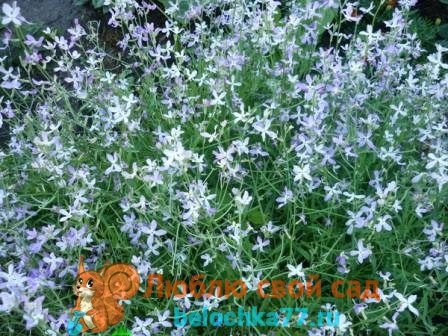

Only when breeding matthiola through seedlings can you get your seeds, this is important for regions with a temperate climate. In the south, seeds will ripen when sown directly into the ground. In order for the fruits to form in the form of pods, it is not necessary to cut off the faded inflorescences.
After the fruit has formed, there must be enough time for the seeds to ripen. This usually happens in September. A sign of seed maturity is the brown color of the fruit. It is necessary to collect the pods on time, without allowing them to open. Then dry them in a dark, dry room and select seeds from them. Seed germination lasts for 3 years.
Care
Perennial plants thrive best in open areas that are well lit by sunlight. The ideal option for growing at home would be the location on the south-facing balcony.
Terry and simple varieties are planted without damaging the earthen coma on the rhizome. Depending on the type of plant, the distance between the seedlings is maintained. A cloudy day or evening time, when there is no bright sun rays, will be ideal for planting. If the seedlings are located too close to each other, it threatens a black leg infection. Matthiola grows well in fertile, loose soil with neutral acidity. Heavy soil and prolonged stagnation of water are unacceptable.
Two-horned matthiola and other varieties are unpretentious in care. They need active lighting and high-quality drainage system. Watering should be regular, but not too abundant. It is recommended to loosen the soil more often so that a dense earthen crust does not form under the influence of moisture. Weed weeding is of great importance, since levkoi do not tolerate aggressive plants in the vicinity.
Systematic feeding of perennial matthiols is not required. In the spring, it is enough to water the seedlings once with a solution of complex fertilizer intended for flowering plants. In the presence of fertile soil, even this is not necessary.
Levkoi are especially vulnerable to fungal attack, in particular blackleg and cabbage keel. To prevent infection, it is necessary to properly care for the plants. Matthiola should not grow too close to each other and be over-watered. The most common pests are considered to be white, cruciferous flea and cabbage butterflies. By treating perennial and annual flowers with special insecticides, you can quickly get rid of their negative effects.
Where is the best place to plant matthiola
To plant this flower, you need to choose the right place, because the degree of lighting and the quality of the soil will affect the growth rate and development of the plant.
Grow lighting
Mattiola two-horned very light-requiring
therefore, the landing site must be appropriate. Short-term darkening will in no way affect the plant, but planting in dark areas will condemn the plant to poor flowering and weak stems. It is also advisable that the Matthiola is not blown by strong winds. It is best to plant this flower in a flower bed near gazebos, benches or other resting places in the country.
Gloxinia, orchid, laurel, wanda, Benjamin's ficus, aichrizon, coleria, begonia, adenium and coleus are light-loving plants, therefore they grow only in open, well-lit places.
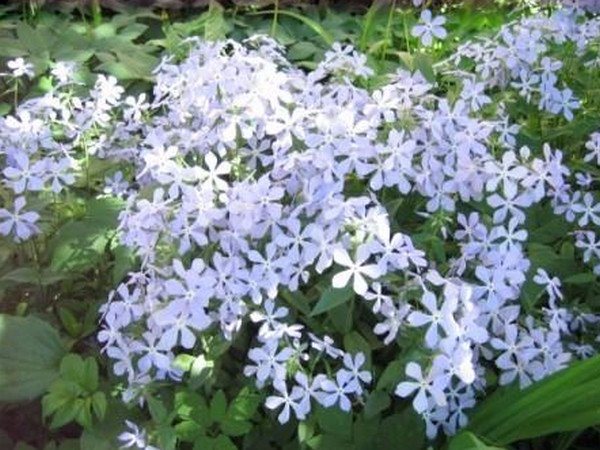

Demanding soil
In order for mattiola flowers to fully grow and develop, planting should be carried out in sandy loam, limed or loamy soil of neutral acidity. Sowing a plant where any cruciferous plants previously grew is not recommended, because it increases the likelihood of matthiola disease with diseases such as fungus and keela that affect the root system.
Important! Mattiola two-horned does not like abundant moisture in the soil, so it should not be planted in low-lying areas.
Landing
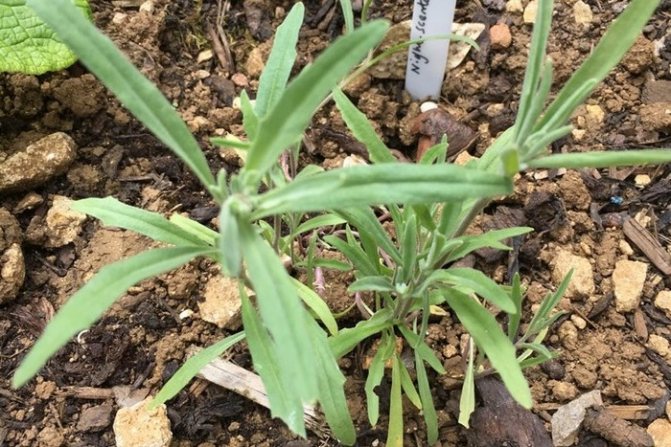

Blooms better, intense smell in sunny places. There are also disadvantages - during extreme heat, the flowers wither, not having time to open. In partial shade, mattiola stretches and blooms worse.
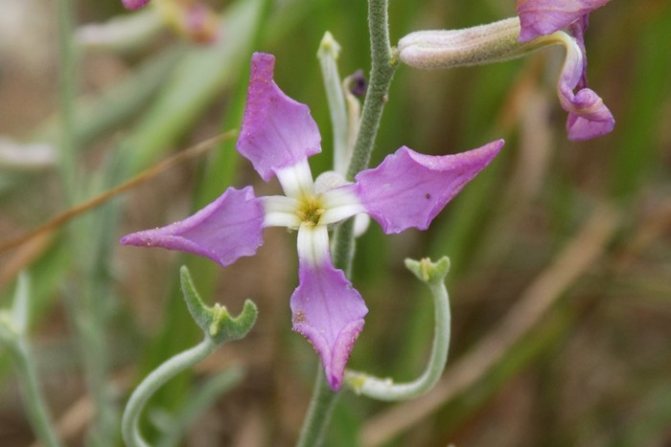

Matthiola two-horned will grow almost everywhere, and likes permeable, medium-fertile soils with a neutral pH. Do not plant on rich soils - it will grow strongly and bloom poorly.
It is better to sow on beds and flower beds by the nesting method. Several seeds are introduced into a shallow hole. The pits are no wider than 10 cm apart. You will get a compact bunch, thin stems adjacent to each other will retain their vertical shape. During watering, care must be taken that the water jet does not incline the plants to the ground.
When grown in containers, matthiola is sown thicker. By adding a lot of gravel to the ground. Top dressing is carried out once a week, with a more diluted fertilizer. Excess nitrogen leads to a loss of flower aroma. Given the small amount of land in the container, watering is carried out regularly, it is impossible to allow the land to completely dry out. For pot cultivation, you can install a metal hoop that is adapted to the size of the flowerpot and hammered into the ground with a pin. The hoop will prevent the matthiola from bending.
The best varieties of mattiola with photos and names
Mattiola Vintage Matthiola incana Vintage
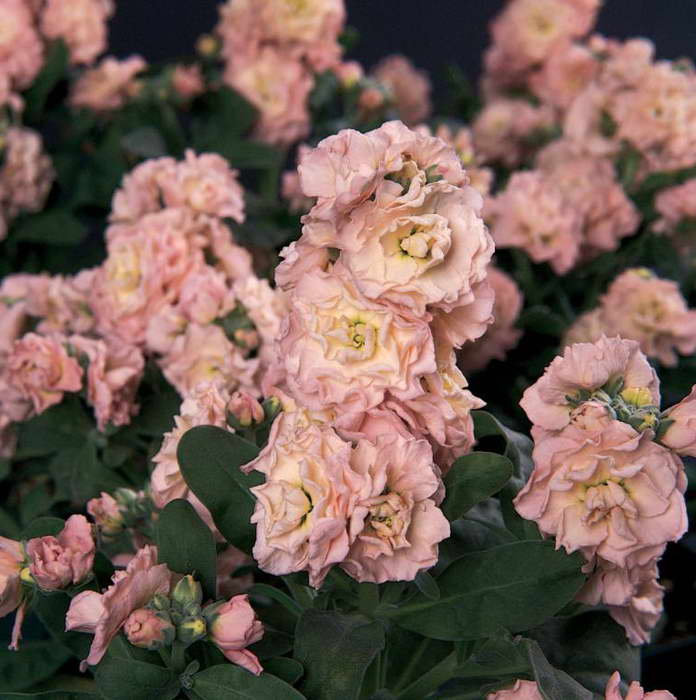

Mattiola Vintage Matthiola incana Vintage Peach photo
Mattiola gray-haired Vintage is an indispensable attribute of garden decoration in the old style. The charm of the variety cannot be compared to any other flower. These are delicate pastel shades, lightness, special purity and lightness. Terry flowers are very decorative, fitting into almost any style of garden design.
Matthiola cinderella
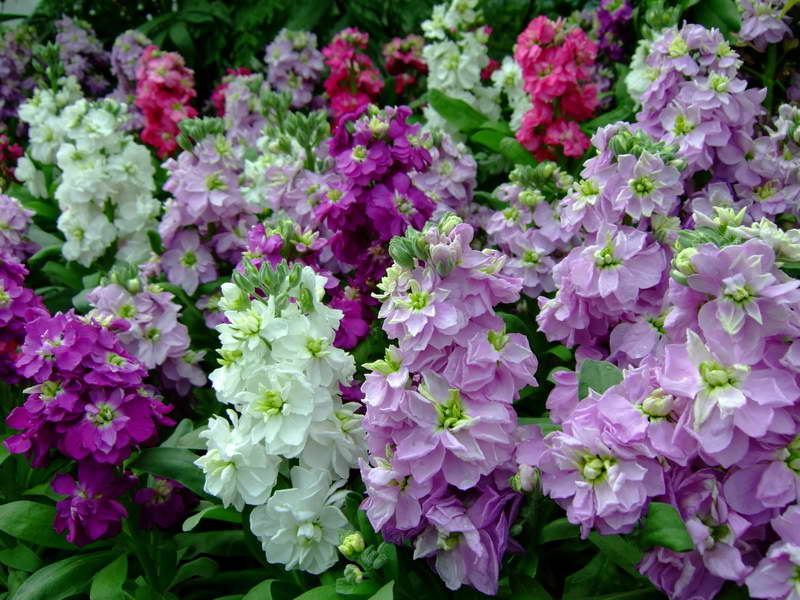

Mattiola Cinderella matthiola cinderella photo
The Cinderella series is distinguished by large double flowers, collected in dense, tall inflorescences. The shades are very diverse, the mix planting looks especially impressive.
Matthiola incana Katz
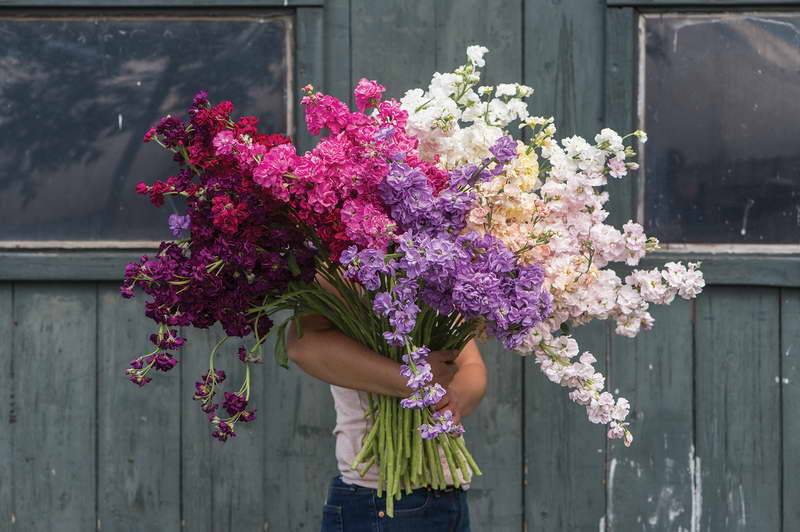

Matthiola incana Katz photo
The Katz series - of amazing beauty bouquet flowers with large double inflorescences on high peduncles. Shades are varied: from white, beige, peach and cream to pink, lilac, purple, lilac and purple.
Matthiola Harmony
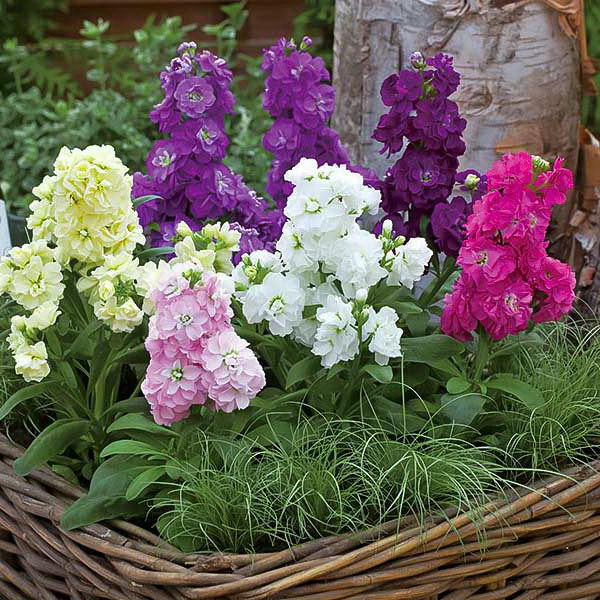

Mattiola harmony matthiola harmony mix photo
The Harmony series is no less charming, looks great in mixed plantings, playing with colors from white-cream pastel shades to rich pink-purple. Inflorescences are large, dense, with massive double flowers.
Matthiola Incana Rich Aroma
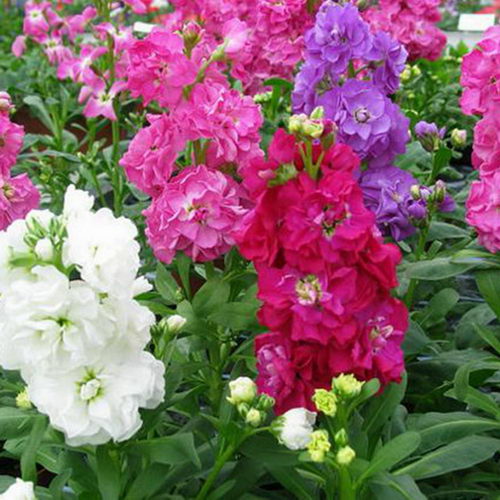

Mattiola Rich aroma Matthiola Incana Rich Aroma photo
Large double flowers of all shades with a thick spicy aroma - this is the Rich Aroma series. Mix planting next to the recreation area will give you an aesthetic pleasure and fill everything around with a pleasant aroma.
Mattiola two-horned lilac variety Lilac Matthiola bicornis lilac
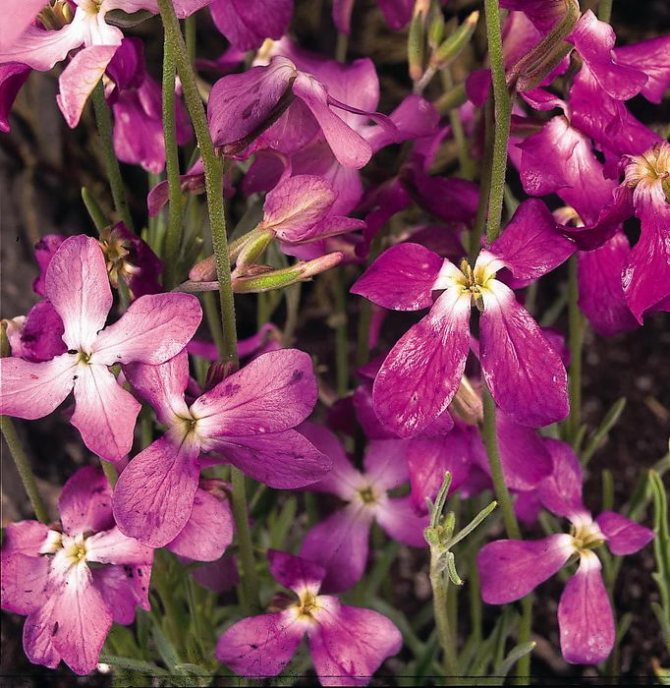

Mattiola two-horned lilac variety Lilac Matthiola bicornis lilac photo
The variety fell in love with its unprecedented endurance: frost and drought-resistant, not picky about the soil, blooms beautifully even in the absence of care. But the most important advantage of the Lilak variety is an incomparable strong aroma that literally fills the space with a whole cloud of a pleasant smell.
Matthiola appleblossom
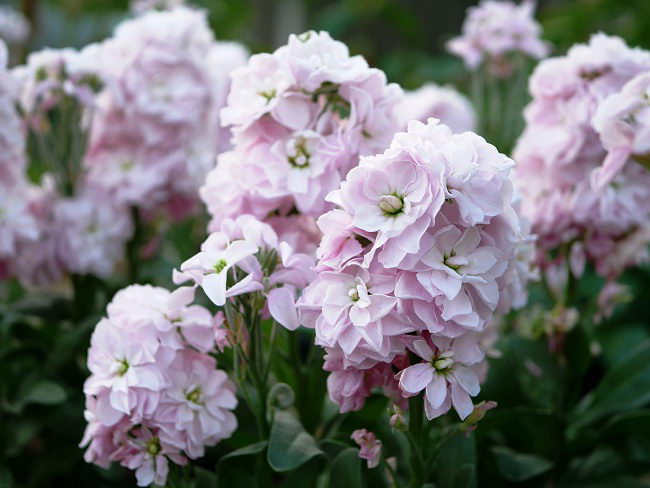

Matthiola Matthiola incana Appleblossom photo
Another vintage variety with delicate double flowers in pastel colors and a pleasant aroma. The flowers really look like apple blossoms.
General description with photo
Mattiola is a herbaceous flowering crop, in the genus of which there are annual and perennial species. The height of the shoots can reach 1 m, but there are also undersized varieties. Stems are branched, hard, woody quickly, many varieties are densely pubescent with soft felt, but there are varieties with bare shoots. The bushes are densely leafy, the foliage is soft, lanceolate, pubescent, its bulk grows in the lower part of the branches.
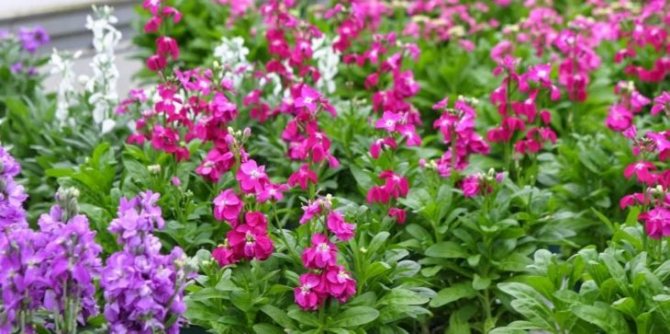

Flowering is early and long lasting, beginning in late spring or June, but there are also autumn flowering varieties. Clusiform loose inflorescences are collected from small buds of white, pink, beige, yellow, lilac, dark-colored varieties in burgundy and purple tones are less common. During the day they are usually closed and only in the evening they open their petals, exuding a sweetish spicy aroma. Matthiola is pollinated by nocturnal insects. The fruit is a small flattened pod, from which many small round seeds of a dark brown, almost black color spill out.
Matthiola easily tolerates a transplant and does not suffer from short-term frosts.
Varieties of matthiola and planting dates
Of the 50 species of matthiola in our latitudes, two are most often grown:
- Matthiola incana - gray-haired or levkoy gray-haired or gray-haired mattiola. The leaves of the varieties of this group are predominantly whitish pubescence. Pink, purple or white flowers can be very different in structure. The flowering period of summer varieties is unusually long - from early summer to winter. Height varies from 15 to 70 cm.
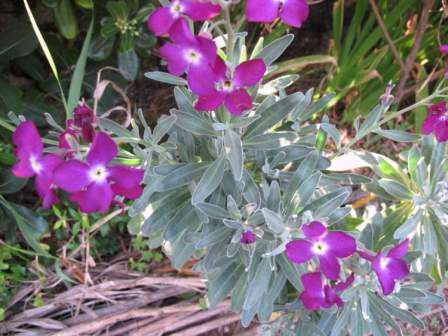

Mattiola gray
- Matthiola longipetala (bicornis) - long-petal matthiola (two-horned). A variety with nondescript flowers that close for the day. In the evening, the flowers open up and exude a captivating scent. Among the people, the gray levkoy was nicknamed the night violet. Summer varieties bloom from early to late summer. The height of the bushes is 50-60 cm.
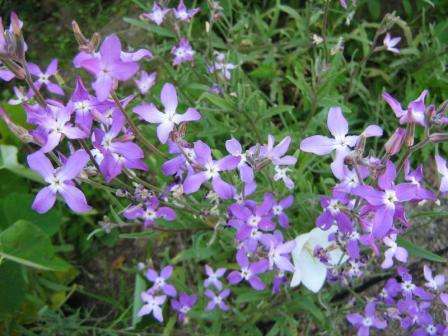

Mattiola two-horned
Mattiola Kverdlinburgskaya
Terry plants of this species are colored greenish. Sizo foliage is green, but the height depends on the variety of the variety.
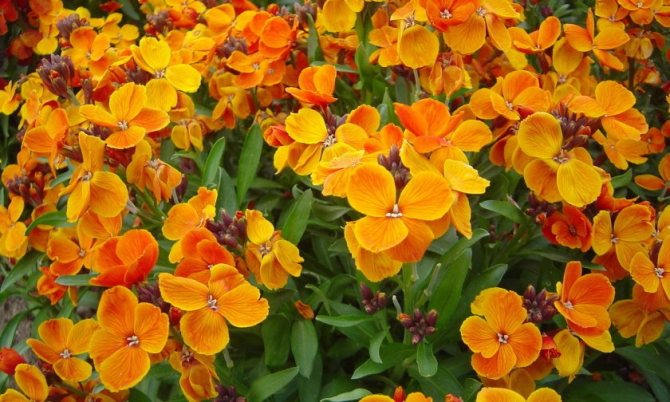

Late mattiola grows more than 50 cm and forms a wide pyramidal bush with large flowers.
An early tall plant can have a stem height of up to 65 cm. They have large leaves and bright flowers in inflorescences. It begins to bloom in June and withers after two months.
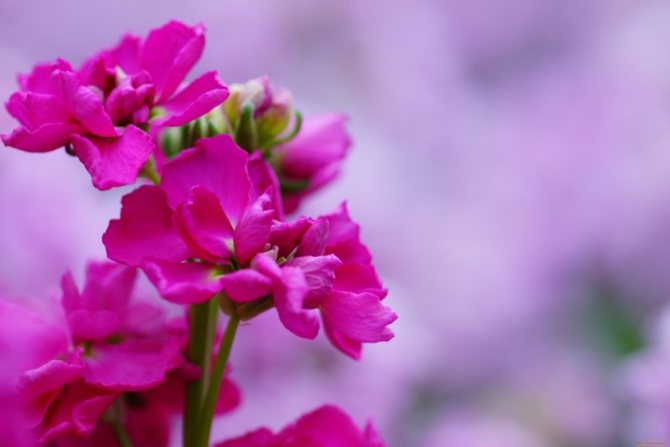

The early low subspecies are spherical bushes not exceeding 50 cm in height. Pleases with flowering a little more than a month.
Plant features
Mattiola is an annual, biennial or perennial herb. Some types of violets are semi-shrubs with branched stems, bare or covered with felt pile. Their height reaches 20 - 80 cm. Flowers can be different: pink, white, yellow, as well as simple and double. Regardless of their appearance, they are all collected in inflorescences that resemble an ear or elegant brushes.
Levkoy blooms from early June to November. The fruits are small pods containing violet seeds.
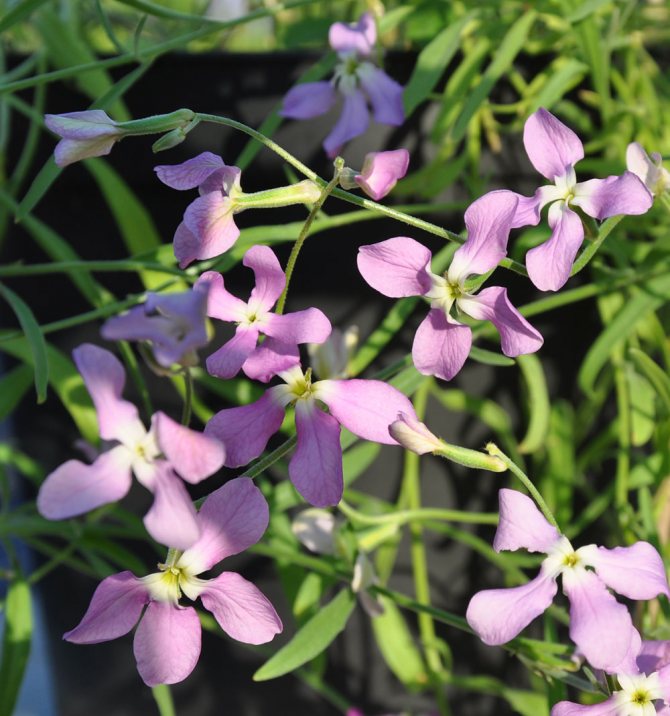

The main distinguishing feature of flowers is a special smell, which simply cannot be confused with anything.
Terry varieties will become a laconic charming decoration of the garden; they are often grown on the balcony. Non-double species are excellent honey plants. Levkoi are unpretentious in care, and even a child can cope with planting in open ground.
How to grow matthiola bicorno from seeds
If you decide to create a blooming fragrant garden, and remember that a plant such as matthiola is best suited for these purposes, then you will begin to ask yourself many questions related to growing it from seeds, courting. Mattiola Is a beautiful flower that enchants with its aromas. You can grow it from seeds. It is only important to know when to plant. In this article we will tell you about all the intricacies of growing this plant.
Seed selection
Of course, seeds are needed to grow fragrant flowers. When visiting a specialized store selling seeds and plants for matthiola, you should definitely ask the seller that you are going to buy matthiola two-horned, or two-horned levkoy. This plant is nondescript, but has a pleasant aroma. Otherwise, you may be sold with a levkoy called mattiola.
Levkoy is more decorative in its external beauty, but as for the aroma, it is much inferior in this quality to mattiola. When purchasing the seeds of this plant, it must be borne in mind that in 1 gram their number exceeds 1000 pieces. But, unfortunately, they cannot boast of a long germination period. And after 3 years, their germination rate will be only 5%.
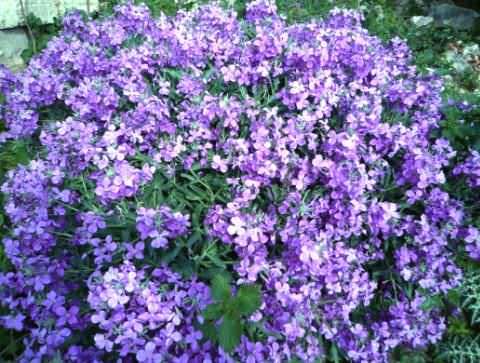

Sowing site preparation
To find out how to grow matthiola from seeds, it is important to read our publication carefully. Consider many points to grow matthiola. When choosing a place for planting seeds, you need to take into account the fact that mattiola flowers are not very mature in appearance, and have no decorative effect at all. They cannot decorate a flower bed in your garden. But, nevertheless, by planting seeds of mattiola next to bright and eye-catching flowers around, you can thus do her a favor.
Mattiola can be perfectly combined with various red or pink border roses. They have practically no aroma. They can be planted in a sunny, open area. Hiding behind low roses, mattiola will only spoil their splendor with its simple appearance, but with the onset of evening it will intoxicate with its beautiful aroma.
There is no need to plant matthiola in a place that you will rarely visit. In the background, this plant should also not be planted, since it will not be able to create a beautiful bright spot, in the shade of other flowers it will not be able to captivate with its wonderful smell.
In some cases, matthiola is planted in a vegetable garden, namely a potato plot. There is a claim that the aroma of matthiola scares off the Colorado potato beetle.
You should not plant mattiola seeds in one place. In the evening, many gardeners just want to take a walk in their area, and the trail of the unforgettable scent of mattiola will develop everywhere.
Whatever place you choose for sowing matthiola, it must be in an open sunny area.
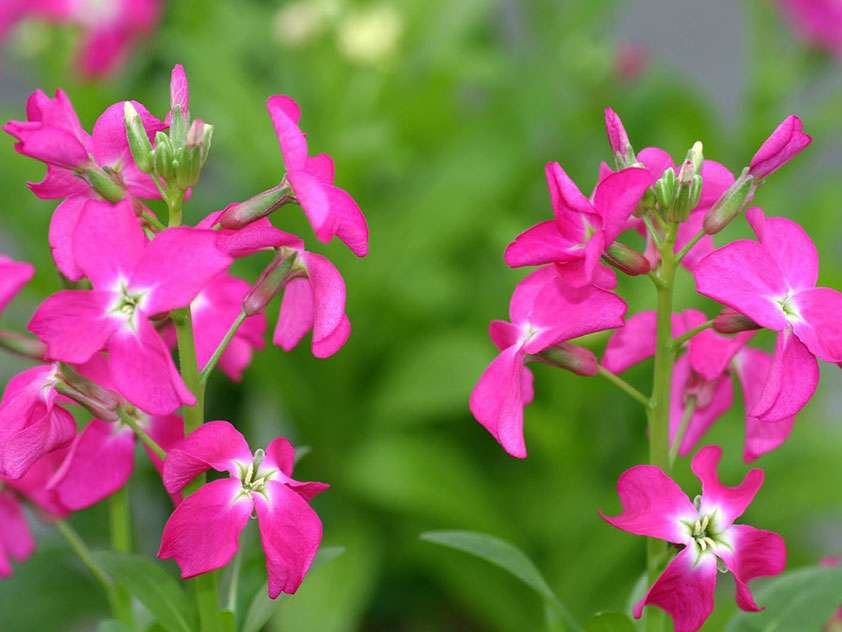

Sowing time
Mattiola flowers require special attention. Proper fit and quality care are essential. You can find a photo of this flower in this publication. Now let's talk about such a moment as sowing time. Even a novice florist can plant matthiola at home from seeds. Mattiola is a hardy plant. For this reason, there is no need for timing. It can withstand temperatures as low as -3 degrees below zero. But nevertheless, it must be taken into account that the first shoots will appear only at positive temperatures, and the shoots that appear rather quickly can be subjected to severe frosts and die. In some cases, matthiola planting is practiced under winter. But this can only be done by living in the southern regions, or it will be necessary to cover the sowing site with a special covering material.
Having determined the place for sowing matthiola, you should not thoroughly fertilize the soil. On well-fertilized soil, matthiola will develop excellent foliage. She begins to stretch, and her growth has a detrimental effect on flowering. As for ordinary soil, it is quite suitable for all requests. But matthiola, negatively affects the acidity of the soil. It requires liming or deoxidation of the soil. When choosing a place to land matthiola, you cannot stop at the lowlands. The root system of this plant is pivotal. She is able to get water for herself from the deepest layers of the soil. But, unfortunately, matthiola does not tolerate excessive moisture.If Mattiola gets wet for a long time, with the onset of a prolonged rainy period, it will stretch out, lie on the ground, and may simply rot.
Mattiola is a southern flower. Large Greek territories 450 years ago were completely entwined with its wonderful scent. In those places, mattiola multiplied on its own. But as for the northern regions, then there should be sure to provide her with proper care and sowing.


Sowing matthiola
Matthiola does not need to be sown in rows or in a line method. Now it's worth talking about how to sow matthiola correctly.
- You just need to level the site, dig it up and sow the available seeds in a scattering.
- Then you should sprinkle them with a little earth and compact them a little.
- After the first shoots appear, matthiol does not need to be thinned out and broken through. In the event that you set a very hot and dry weather, then in the first days it is better to water Matthiola, so that the first shoots and rooting can appear.
- Mattiola does not flower for a long time. After the pods with seeds are formed, its aroma will become almost invisible. In the event that you do not need seeds, then prune the plant by 24-30 cm. After a certain period of time, mattiola will grow again and give you an amazing aroma. You can cut off not the entire plant, but only a certain part of it.
- Do not rush to pick off the seed pods. Give them time to mature well. But you should not let them fully open up, because you will lose the seeds. In the event that wet weather is established, matthiola pods can be cut unripe. But then, spread them in a dry place and dry well.
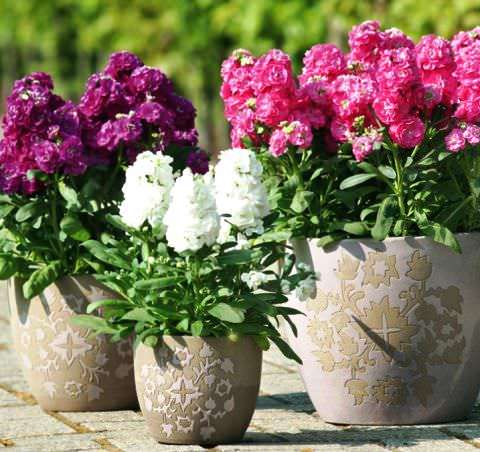

Summing up
Mattiola evening aroma is wonderful and at the same time not whimsical plant. It is worth doing the right cultivation from seeds and after a while you will be able to enjoy the amazing aroma. There are not many methods for growing matthiola. In order to be able to quickly enjoy its enchanting aroma, in rare cases, sowing matthiola on seedlings is used. Due to the presence of a taproot in matthiola, it was previously believed that if the transplant is carried out together with an earthen clod and at the age of 2.5-3 weeks, then the survival rate will be excellent. planting matthiola seedlings is little practice due to the short flowering time, and the acceleration of growth lasts only 2 weeks. Based on this, as a rule, direct sowing of seeds into open soil is applied. Matthiola is not afraid of pests, she practically does not get sick with various bacterial, fungal or viral diseases. Excellent aroma, unpretentiousness, ease of care - all these advantages relate to nondescript matthiola. Therefore, you should choose this flower for planting in your personal plot.
Video on the topic: How to plant mattiola levkoy at home. Sowing planting growing matthiola. Planting matthiola
Also read:
- How to grow perennial plants for the summer cottage
- How to properly plant ranunculus. All the secrets of growing
- What annual flowers bloom all summer. Catalog…
- We plant undersized perennial flowers on our own
- Interesting crafts for giving with your own hands. Ideas and photos
- We arrange beautiful flower beds ourselves and ...
- Catalog of unpretentious and small perennials. ...
- Growing grapes in the middle lane for beginners
Meet the queen of the night
The progenitors of matthiola grow on the territory of Greece and Asia Minor; mentions of this plant are known already in the 16th century. This annual is distinguished by its eccentricity, in the daytime the flowers are covered, but with the onset of the evening they open and begin to exude a pleasant aroma.
The plant, depending on the variety, can be erect or spreading, with proper care it can reach 60 cm in height. The stems and leaves are strongly pubescent, the foliage is bright green, bordered by teeth.
The inflorescences are collected in a brush of rather pale tones, the flowers are small, simple, sometimes double.Flowering begins in July and lasts until the first cold snap. After flowering, pod-like fruits with very small seeds are formed, the germination of which lasts for three years.
In nature, there are over 50 species of matthiola, it is also a fragrant violet, however, flower growers are engaged in breeding only two of them:
- Mattiola is two-horned;
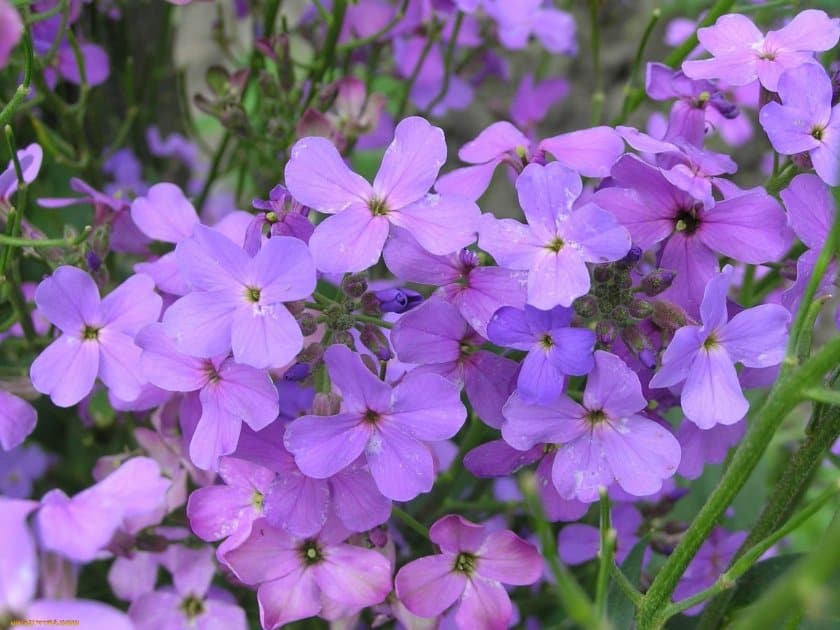

- Levkoy or gray-haired mattiola.
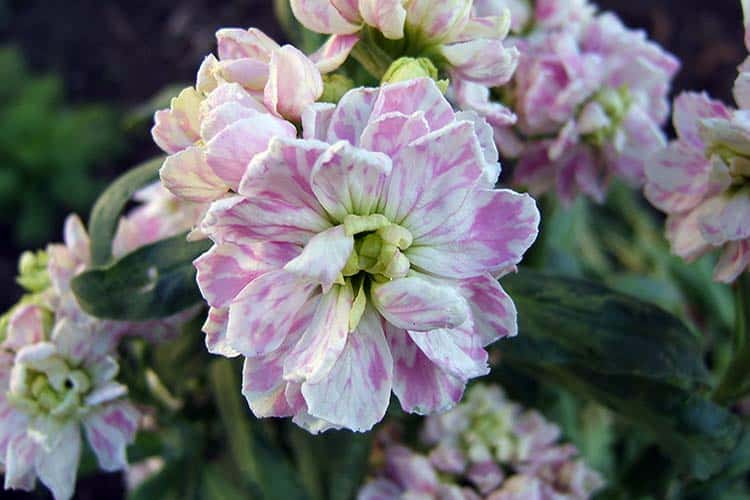

Now breeders have created dozens of various varieties of violets, each of which differs in appearance, color and aroma. Today we will deal with one of the two-horned mattiola varieties, namely the "Evening aroma". This variety is distinguished by abundant branching.
The height of erect shoots reaches half a meter. The flowers are incredibly fragrant, medium-sized, delicate lilac shades.
How to properly care for flowers
The plant does not require any special care. Even a novice florist can follow him. We will tell you the most important features of growing flowers.
Watering rules
Matthiols are very fond of well-moistened soil,
therefore, they need to be watered regularly, especially during dry weather. But do not pour a lot of water at a time, it is better to divide the watering into several stages so that the water flows gradually and has time to be absorbed into the soil.
Fertilization features
Any organic fertilizers for matthiola are contraindicated, so you can only use mineral purchased fertilizers for flowering plants. You need to dilute them in water, following the instructions, and feed them. If the soil is fertile, such procedures will need to be carried out 4 to 6 times, for poorer areas - 6-8 times.
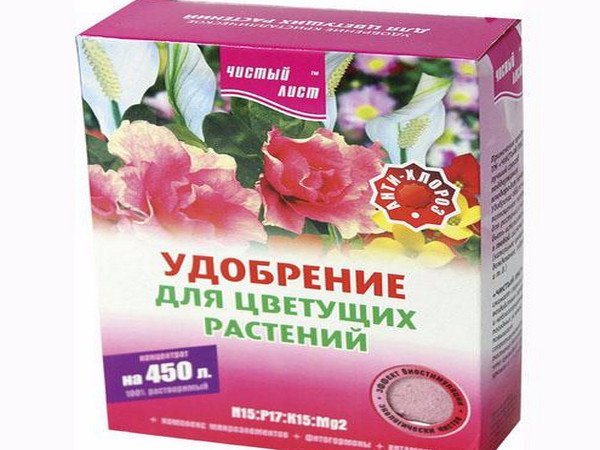

Important! In order to obtain a large number of flowers, fertilizers must be applied at the stage of budding matthiola.
Soil care and weed control
To keep the plant healthy throughout the growing season, you need to regularly weed the area, removing all weeds and loosening the soil. This should be done with extreme caution so as not to damage the already fragile stems of matthiola.
Pests and diseases of the "Evening aroma", their prevention
This is not to say that matthiola is highly susceptible to attacks by harmful insects or diseases, however, as with the cultivation of any other crop, you should always be on the lookout. The most common diseases are fusarium and keela, both of which are spore-propagating fungi. Unfortunately, spores overwinter easily outdoors.
Of the dangerous insects, cabbage, whitefish and cruciferous flea can be distinguished. The latter, along with caterpillars, can completely destroy crops of matthiola. To prevent this from happening, you must constantly carefully examine the plants. You can cope with all the problems with the help of special preparations from the flower shop.
Do not wait for insects and diseases to seriously damage your flowers, it is much easier to prevent any problem than to eliminate its consequences.
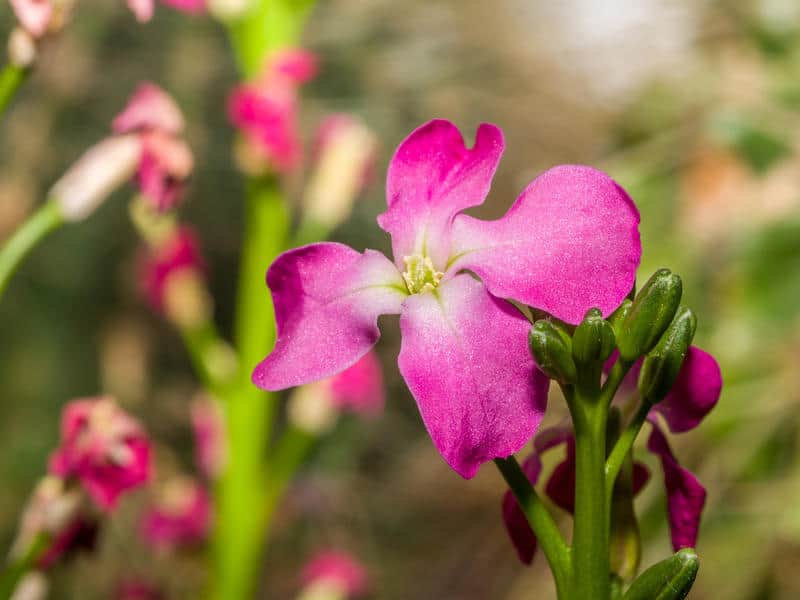

To do this, pay attention to a few useful tips from experienced florists:
- As a prophylaxis for the disease with a keel or black leg, spill the earth with a saturated solution of potassium permanganate, wood ash or special fungicides;
- At the slightest sign of Fusarium infection, the bushes should be treated with preparations intended for this, having previously plucked and destroyed all damaged foliage;
- Two-horned matthiola belongs to the cruciferous family, and just like its relatives, it is attacked by cabbage and white butterflies. You can save yourself from them by spraying flowers with valerian tincture, since they cannot stand its smell. To prepare a magic solution, stir a small spoonful of valerian in a liter of liquid;
- You can scare off a cruciferous flea with ordinary wood ash. After watering and rain, simply dust the bushes with ash.
Sowing with seeds in the ground
- First, you need to find a suitable site for Matthiola "Evening aroma".It should be sunny so that the plants do not stretch out, protected from gusts of wind so that the bushes do not break.
- The soil at the planting site should be soft, loose and rich in nutrients. However, it is not worth bringing humus under the culture, as this can cause infection of the violet with late blight. Matthiola grows well on loamy and sandy loamy soils with neutral acidity.
- Cultures preceding planting are no less important; areas where representatives of cruciferous plants were previously grown are not at all suitable. This can lead to damage to flowers by fungal diseases and keel.
- It is good if you prepare the soil on the site in the fall. Careful digging will save the soil from spores of fungi and black leg that are going to winter in it. It is necessary to dig it to a depth of 40 cm; simultaneous composting will give a good result.
- Matthiola "Evening aroma" does not have to be planted on a separate ridge, it will look much more interesting with other crops with large, bright inflorescences. It can be planted both in spring and autumn.
- The soil prepared for planting is well spilled with a strong solution of potassium permanganate, well loosened and shallow grooves are made. Their depth should not be more than half a centimeter, otherwise weak shoots will not be able to break through a thick layer of soil.
- For even distribution of achenes over the surface of the earth, they are mixed with sand and poured into the grooves.
- Next, the crops are carefully sprinkled with earth, its layer should not be more than 0.5 cm. In no case do not compact the planting, carefully water the ridge.
- Mattiola seedlings will appear by the end of May.
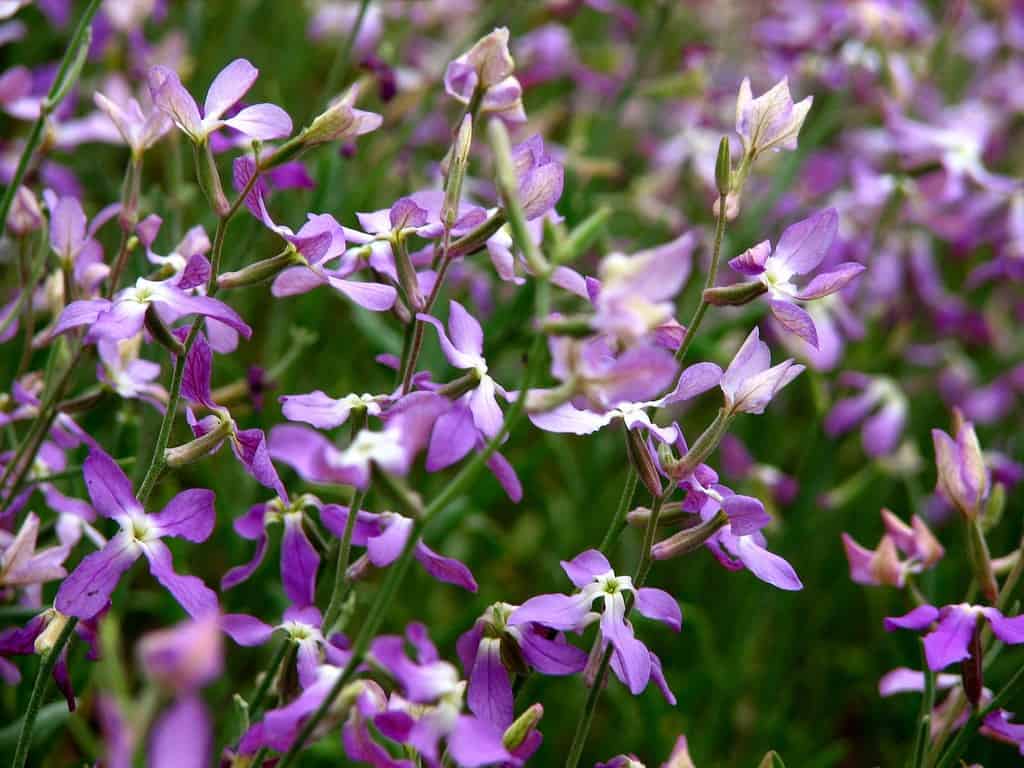

Types and varieties with photos
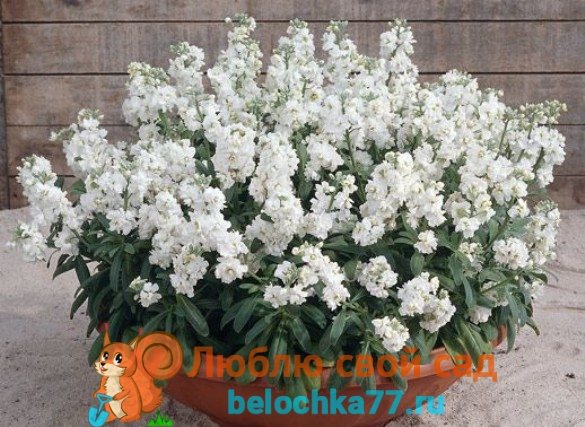

Under natural conditions, 50 species of plants belonging to the genus Matthiola will grow, several species have been domesticated. In the temperate climate of the middle zone, two types of plants are grown as ornamental open ground crops:
- matthiola two-horned;
- mattiola is gray.
Mattiola two-horned
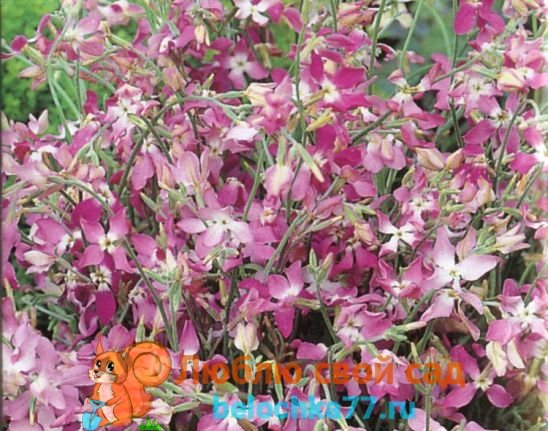

Mattiola two-horned is an annual crop. Height about 50 cm. Sprawling, branched bush. Leaves are oblong, oval, pubescent. Blooms all summer, starting in June. Inflorescences racemose, composed of small flowers, greenish-purple, white or yellow.
A plant with a strong pleasant aroma, especially noticeable in the evening and at night, since the flowers open after sunset, and are closed during the day. Fruits are formed at the end of summer. They are rather long pods with small horns at the top.
The seeds are flat, gray-brown in color, small in size. Seed germination lasts for two to three years. You can sow seeds in the ground in the fall. In the horticultural market, the species Matthiola bicorn is represented by several varieties. Most Popular:
- Evening scent.
- Star Light.
- Night violet.
- Lilak.
Variety Evening aroma
The most popular variety has a strong, pleasant aroma. Bushes of medium height - 45 cm, has an erect stem with many branches. Lilac flowers, collected and loose racemose inflorescences, close at sunrise, bloom in the evening. Abundant flowering. Can grow in partial shade.
Mixture Starlight
The flowers of this variety have a low decorative effect, but they have an exquisite aroma, the colors can be very different. Height is not higher than 30 centimeters. The variety is recommended to be used to decorate lawns, balconies, garden paths. Usually flowers of this variety are planted near benches and under the windows of the house. The plant is not afraid of small cold snaps (-5 ° C).
Variety Night violet
Annual plant - Mattiola Night violet is low, maximum height 25 centimeters, cold-resistant, loves sunny places. The flowering period is long. When planted in late April, early May, it starts flowering in June and ends in September.
It grows quickly, reaching half a meter in height. Stems are densely branched, covered with large toothed leaves.The racemose inflorescences are closed during the day and bloom in the evening, spreading an exquisite aroma, and can be used for cutting.
Mattiola Night violet combines well with other flowering plants, can be used to decorate mixed flower beds. The plant looks great against the background of green lawn grass, next to gazebos, terraces, benches.
Lilak variety
Mattiola Lilac is a cold-resistant, annual plant that prefers well-lit areas. The stem is of medium height (50 cm), densely branched, covered with large, serrated leaves.
The inflorescences are racemose, lilac bloom at night, have a fascinating aroma. The beginning of flowering is early, only 60 days pass from sowing, and long (2 months). The Lilak variety is usually planted in flower beds located next to gazebos in combination with other flowers.
Mattiola flower. Description, features, types and care of matthiola
The new is the well-forgotten old. So it can be said about mattiola or night violet. How can you not be mesmerized by the extraordinary aroma of flowers in the evening.
Therefore, it is increasingly possible to find cultivars in the garden and on the balcony. The breeders have contributed to the development of new varieties of matthiola, which are not only fragrant, but also with new double buds that are pleasing to the eye.
Description and features of matthiola
In horticulture, two types of annual and perennial are most common. matthiola: two-horned and levkoy (gray-haired). Both species grow in the form of shrubs and herbaceous plants. Combines two types of extraordinary aroma flowers matthiolathat you can smell in the evening. In the daytime, the buds close.
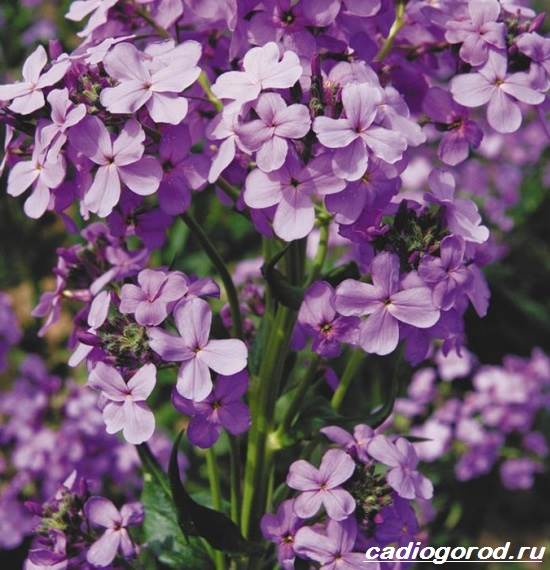

Mattiola two-horned
Matthiola bicorno flowers are inconspicuous and very small. Gardeners develop varieties of this species exclusively for aromatherapy. They are planted near the paths, near the benches, so that you can enjoy the fragrance.
The breeding method is only seed. They retain their germination capacity for up to 3 years. The plant is frost-resistant - a strong cold snap to minus 5 degrees C will not be able to destroy the plant. Therefore, it takes root well in the northern regions of Russia.
Mattiola Levkoy differs from the previous species in flowers. They not only have a scent, but also look beautiful on flower beds, forcing. Although in smell they are much inferior to the two-horned species. The buds compensate for this deficiency.
Flower petals can be double or simple. Reach up to 8 cm in diameter. The bushes can have a length in the range from 20 cm to 80. Therefore, they can be conditionally divided into some groups according to their height. When the growth is up to 20 cm, they are classified as dwarf varieties, medium-sized - 45 cm, high - 80.
Shoots are single-stemmed or branched. The color, depending on the variety, can be different: white, golden, lilac, reddish, lavender.
It can be grown by seed and seedlings. Moreover, only varieties with simple petals can produce seeds. Terry varieties are grown for decorative purposes.
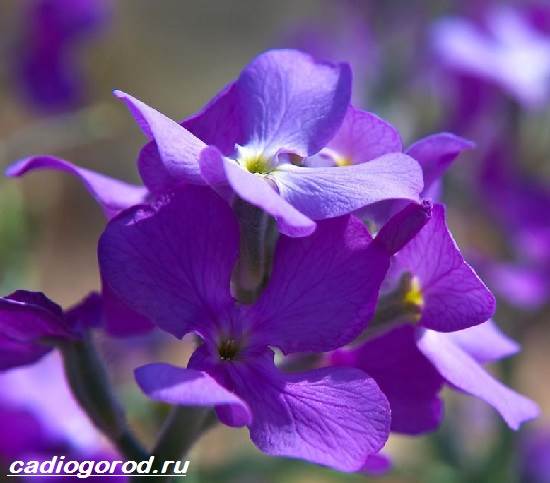

Levkoy can bloom, depending on the variety, in three different periods. In the garden, bushes are grown that bloom only in summer. Plants love open, sunny places, but do not tolerate fresh organic matter as a top dressing. It is used six months before planting, then, only mineral fertilizers.
Planting and reproduction of matthiola
The predecessors at planting matthiola there should not be cruciferous representatives: horseradish, mustard, radish, cabbage. This is considered the main condition growing matthiola... Otherwise, the flowers are doomed to disease.
The landing site is sunny, although it can grow in partial shade. The land is acceptable, non-acidic, loamy, fertile and well moistened.
Matthiola bicorno is grown by seeds in the spring:
- Before how to plant matthiola prepare the soil in the fall. For this, soil is being dug with the addition of organic matter.
- April is the time when sowing mattiola into open ground.
- Wells are prepared with a step of 20 cm.In each hole, 5 are sown matthiola seed.
- The planting material is mixed with sand, sprinkled with a layer of soil on top. After one week, one and a half, shoots can be expected.
- Discharge the seedlings, leaving the strongest ones.
- Flowering is expected in 30 days.
- Experienced florists to extend aroma of matthiola in the garden, the seeds are planted in several steps, with a gap of 10-14 days.
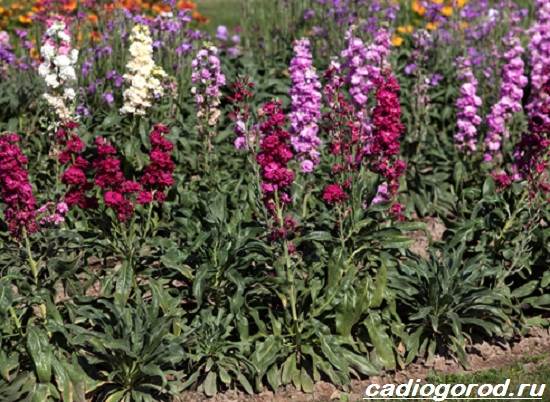

The seedling method of reproduction for this species is not used, since the root system suffers when picking. As a result, it does not take root well, but for matthiola, gray-haired reproduction in this way is acceptable:
- In February, the planting of seeds in peat-melted cups begins.
- The planting material is kept for several hours in a weak solution of potassium permanganate.
- The composition of the substrate - sod land, substrate (3: 1).
- Boxes with cups are kept in a cool place with an ambient temperature of 13-15 degrees C.
- As soon as shoots appear, the temperature of the environment is reduced to 8-10 degrees C and taken out to a bright place. A drop in temperature will have a positive effect on flowering, which will happen one month earlier.
- A pick is carried out in the presence of two real leaves. The roots are slightly trimmed during transplantation. Then they will bush better.
- Planting seedlings in open ground occurs in May. The root system of flowers will not be affected if the seedlings are planted with the cups.
- The seedling method will allow you to see flowering much earlier than with the seed method.
Levkoy is planted at home for distillation. In the summertime, flowerpots are taken out with mattiola on the balcony, terrace.
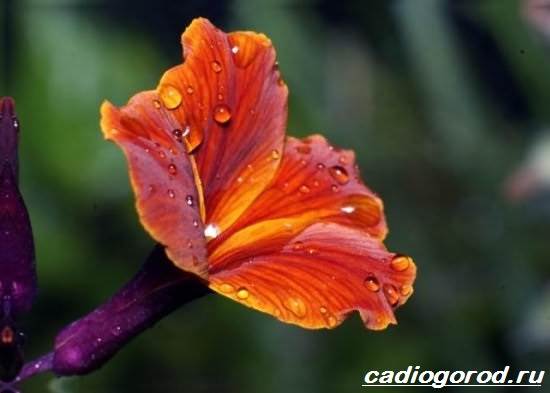

Inflorescences of this species are double and simple. An interesting detail - you can distinguish them when the leaves appear. Terry varieties have large leaves of rich green grass, simple ones - small leaves of a dark green hue. That makes it possible to grow decorative varieties with terry leaves purposefully.
Matthiola care
The plant is considered unpretentious, so even a beginner can grow it. Fulfilling small requirements, the bushes will bloom and smell:
- Mattiola is a winter-hardy plant, but does not tolerate heat. Therefore, the flowers should be watered abundantly. The procedure is carried out in the morning in two steps (10 minutes break) to allow the flowers to get saturated with moisture. Evening watering is undesirable, as it provokes diseases. Drip irrigation is well suited for bushes, just do not forget about the overabundance.
- IN caring for matthiola use mulch - this will protect the bushes from weeds, retain moisture in dry weather.
- Seeds are obtained only from mattiola levka with simple inflorescences. Therefore, terry faded buds are immediately cut off for greater decorativeness.
- Flowers are suitable for cutting and creating various compositions. For these purposes, the plants are pulled out of the soil with roots. Free from the ground under running water. Then, the bouquet will last 30 days.
- The shrub responds very well to feeding. The flower loves organics only before planting. It is brought in in the fall, and the plant is planted in the spring. Fertile soil needs mineral fertilizers up to 5 times a season. Then, as poor soils are fed even more often - 8.
- Loosen the soil, but very carefully so as not to injure the stems.
- Remove weeds in time, do not leave on the field.
Types and varieties of mattiola
In the wild, there are 50 species of matthiola. The most popular in floriculture are two types: mattiola two-horned, mattiola levkoy (gray-haired). Each species is the ancestor of many varieties.
Dwarf varieties of mattiola Levka grows in height only up to 20 cm. Flowers are small, as well as leaves up to 2.5 cm in girth. Used for planting along curbs, planted in pots on terraces and balconies, have a different color.
Among the dwarf varieties, there are large-flowered specimens with a diameter of 8 cm. Inflorescences with double petals and a divine smell.
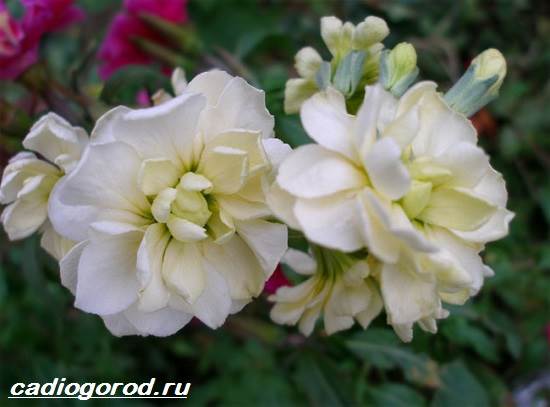

Mattiola snowflake
In the photo mattiola "Snowflake" with incredible white buds.
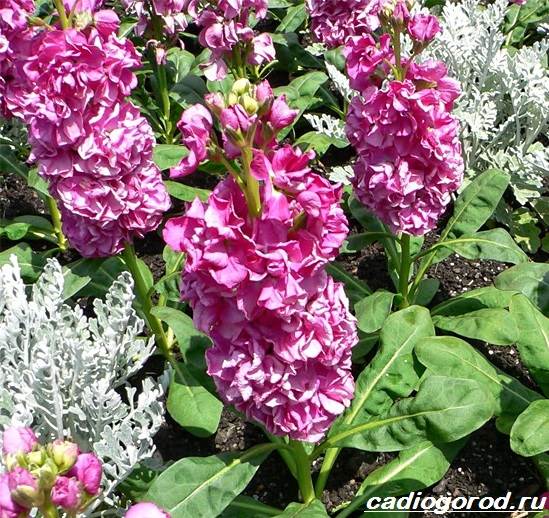

Mattiola Thumbelina
"Thumbelina".Crimson buds will delight not only the garden, but also the balcony, terrace.
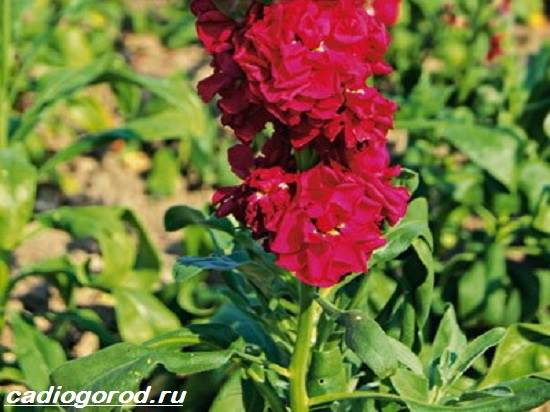

Mattiola Ruby
"Ruby". The name speaks of the beauty of a "precious" reddish flower, sitting in the form of a panicle on the tops of the shoots.
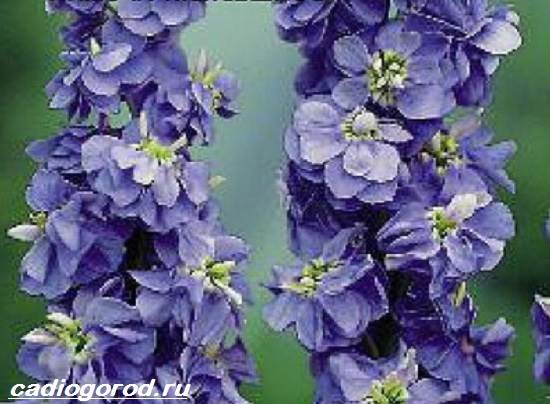

Matthiola sapphire
"Sapphire". Peduncles clearly hold a spikelet panicle with pale blue petals.
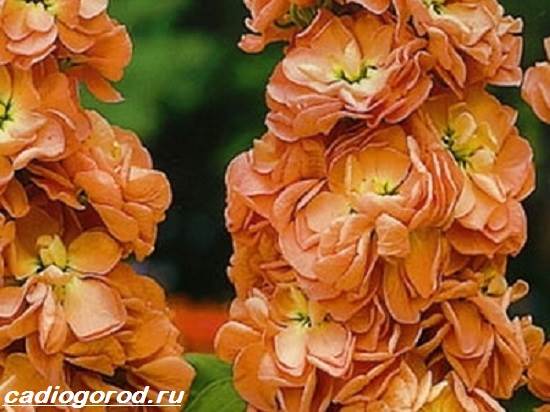

Mattiola is pure gold
"Pure gold". The buds are in the form of yellow-orange candles.
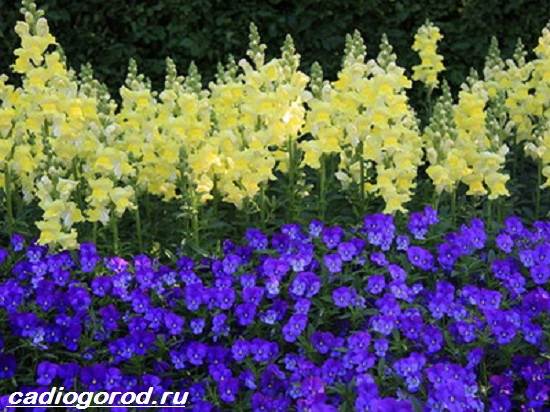

Mattiola Rita Blosei
"Rita Blosei". Includes a variety of blue and yellowish white buds. Semi-high grades of mattiola levkoy stretch up to 34-40 cm. They have double buds. Shoots are collected in a compact pyramidal bush.
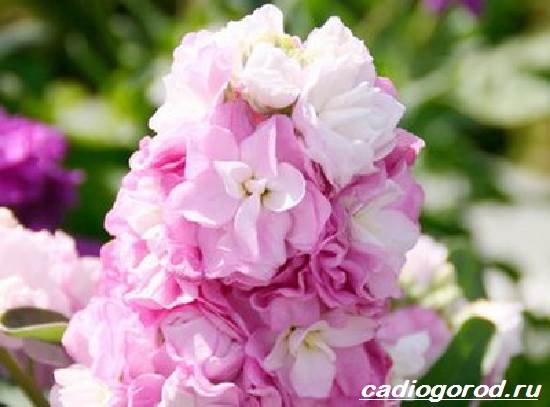

Mattiola north
"Northern". Pink-white buds
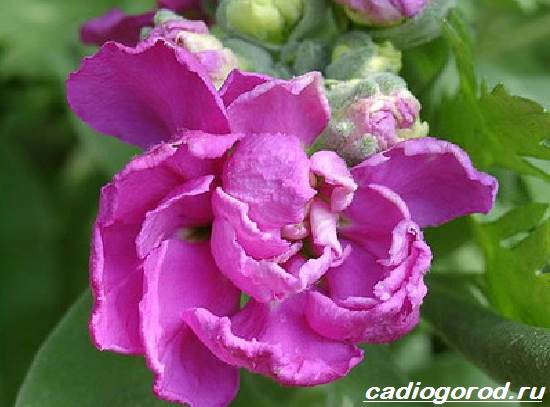

Mattiola standard
"Stamp". Erect stems, at the end of which lilac buds flaunt.
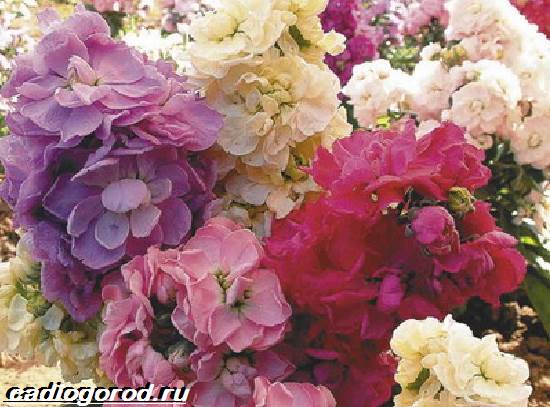

Mattiola gigantic
"Gigantic". The variety captivates with a variety of colors
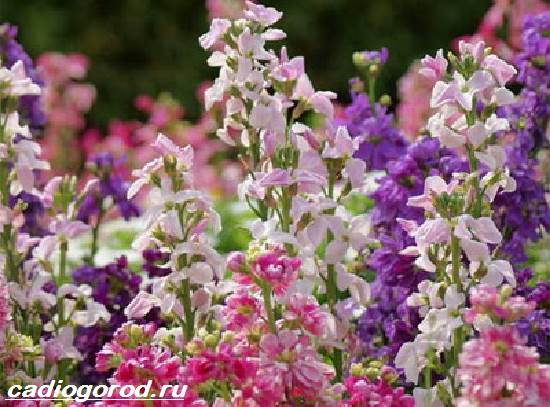

Mattiola repairing
"Remontant". Flowers are collected in an ear with lilac, pink, white shades.
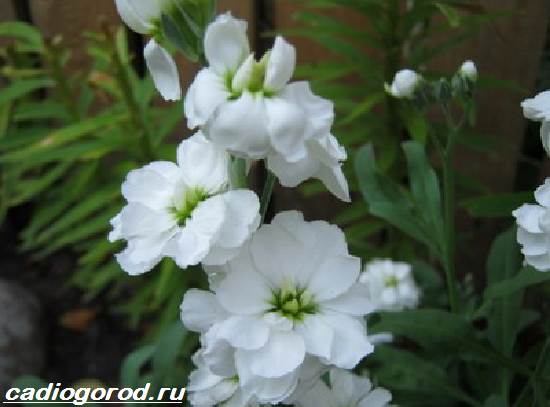

Summer mattiola
Summer. As if a bride in a white dress smells fragrant on a peduncle.
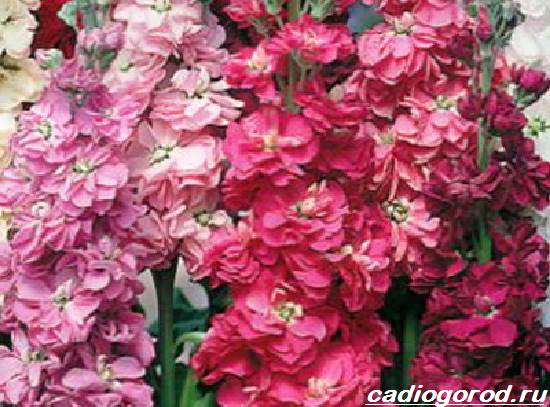

Mattiola grandiflorum
"Large-flowered". The unusually large buds look great in bouquets. Varieties of Mattiola bicorno are distinguished by small and inconspicuous flowers of various colors. Florists grow them exclusively for aroma in the evening. Bushes up to 50 cm high.
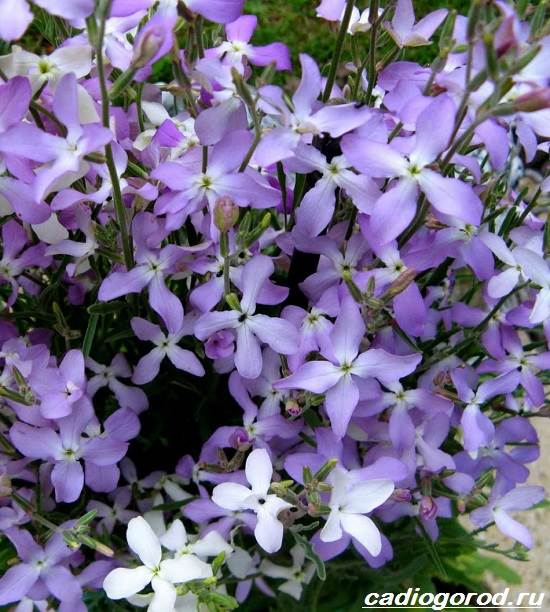

Mattiola Star Color
"Star Light". The colors of the buds are played with different colors.
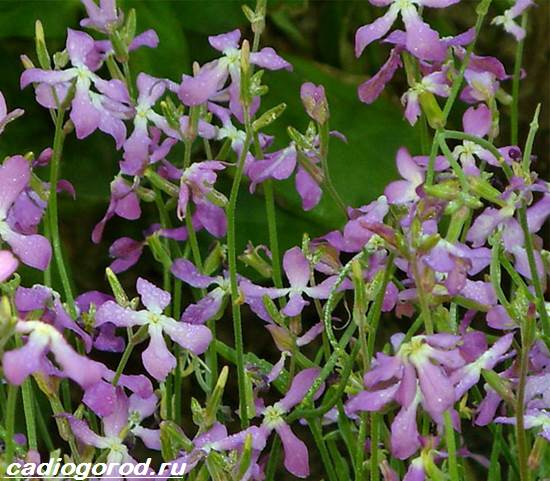

Mattiola evening fragrance
"Mattiola evening fragrance - lilac mattiola." A pleasant and strong aroma does not leave indifferent people passing by a flower garden with modest miniature flowers.
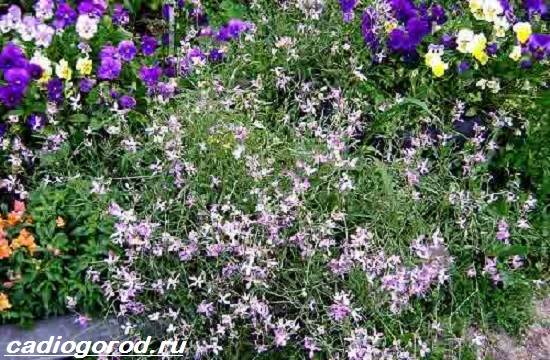

Mattiola night violet
"Night violet mattiola ". A compact small bush that will look great in live compositions.
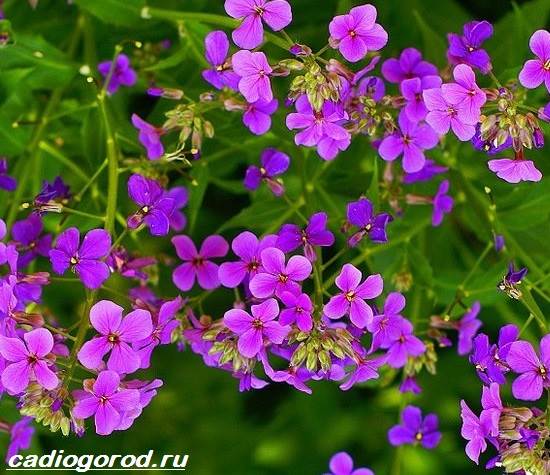

Mattiola lilac
"Mattiola Lilac". Delicate buds of light lilac color are in perfect harmony with bright neighbors in the flower bed. An annual plant. Belongs to the category of cold-resistant varieties.
Diseases and pests of matthiola
Root or keel disease is a fungal disease. A favorable environment for infection is a warm, humid environment, soil acidification. Symptoms: the color of the leaves takes on a light shade, wilting in hot weather.
Plants are infected through the hairs of the root. It is possible to exclude infection with a keel if the predecessors are not representatives of the sacral family. Pathogens can be in the soil for up to 15 years. Struggle: pull out plants, burn. Treat the soil with chemicals, add lime.
Fleas. Insects attack in dry weather. The leaves are covered with holes. Struggle: water and sprinkle with ash, tobacco dust, soil. You can also spray flowers:
- Ash tincture. It is necessary to prepare the product in the evening, and in the morning to spray the bushes.
- Horse sorrel root tincture.
- Dry tops from tomatoes.
- Shampoo for dogs (for fleas).
- Use insecticides as a last resort. Since they are harmful to human health, the microclimate of the garden.
Cabbage whitefish. There is no harm from a butterfly to a flower, but its caterpillars greatly harm the plant. In spring, butterflies lay their eggs on the back of the leaf. If you look at the appearance, they have a yellowish tint.
Symptoms: Caterpillars overeat the leaves of the plant around the edges. Why the flowers lose their decorative effect. Fighting: before planting flowers, the planting area should be cleared of weeds.
If you have caterpillars, you can collect them mechanically from the leaves. If there are too many of them to treat infected bushes with insecticides, for example, Kinmins, Fury.

